Cancer Diaries
Part Three:
Burzynski
The Modern Prometheus
Written by Rick Archer
July 2013
This is the story of a cancer
researcher named Stanislaw Burzynski.
Based on what I have read, it looks like
this man has found a cure for cancer.
His treatment doesn't work all the time, but
when it does work, the results are
spectacular.
You would assume this would be a celebrated
man, but he isn't. Like Prometheus who
brought fire to mankind and was punished by
the Gods for his hubris, Burzynski has been
chained to the mountain many times and
clawed at by eagles.
This is a remarkable and deeply disturbing
story. Let's go.
|
 |
Stanislaw Burzynski
I will
get right to the point.
Stanislaw Burzynski presents
the most serious threat to
the Pharmaceutical Drug
Cartel in history.
Why? Not only does it
look like Burzynski has a
cure for cancer, get this:
he owns it!
Assuming his treatment
fulfills its promise, left
unchecked, this man could
destroy the entire rotten
cancer treatment system.
Not surprisingly, the drug
industry, the NIH, and the
FDA absolutely hate him.
Not only that, they fear
him.
Assuming you read my
previous
story, you will
recall that the Medical
Establishment appears to
have successfully quashed
several promising cancer
cures in the past.
In
Burzynski, it seems like 100
years of Bad Karma has come
back to haunt the forces of
evil. Dr. Burzynski is
the modern day successor to Essiac,
Hoxsey, Gerson, and Laetrile
all rolled into one.
Stanislaw Burzynski
is now the chief renegade.
|
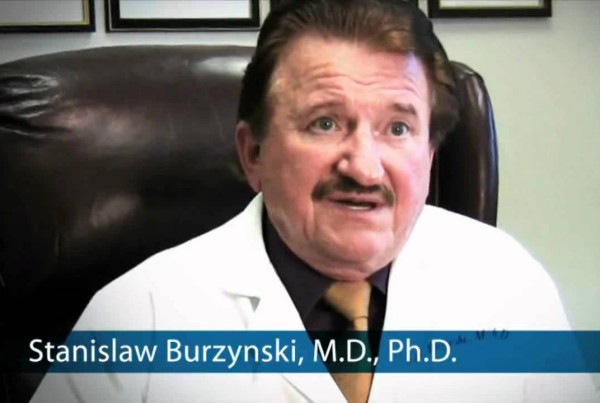 |
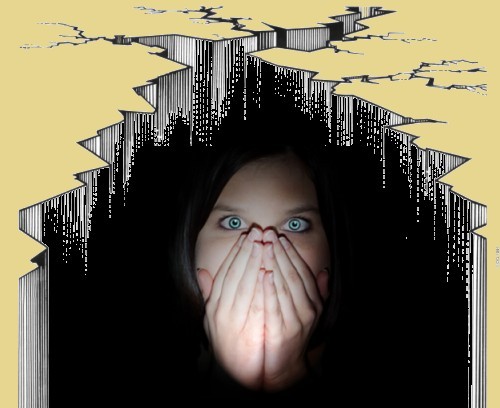 |
Into the Abyss
Burzynski presents a huge
threat to the Medical
Establishment for several
reasons. First, like
Max Gerson, he is the
graduate of an accredited
medical school in Poland.
This gives him the right to
treat patients.
In addition, Burzynski holds
a PhD in biochemistry.
Since he began his career as
a cancer researcher for the
National Cancer Institute
(NCI),
Burzynski is no stranger to
the world of
research and its intricate
games.
Far from it. Burzynski
appears to be a crafty
player who knows how to
play the research game inside and
out.
That
means that like Max Gerson
from my previous chapter, Burzynski is
simultaneously both an
Insider and an Outsider.
However, despite his
profound brilliance, Max Gerson
did not appear to have a
fighter's instincts.
That is where Burzynski and
Gerson differ.
|
Instead, when it comes to
the rough and tumble hardball
tactics of propaganda,
disinformation, harassment,
and legal intimidation used
by the Cancer Drug Cartel,
Burzynski is clearly much
better prepared to fight
fire with fire than Gerson
ever was. In the
tradition of Harry Hoxsey,
an alternative cancer figure
from yesteryear, Burzynski
is a fighter. He
doesn't back down.
If there is
one statistic that says it
all, that would be the fact
that the U.S. Government
at both the State and
Federal level spent 14 years
continuously fighting
Burzynski in the court of
law. That's right,
there was an endless series of cases that
stretched all the way from
1983 to 1997.
I may
have my math wrong, but by
my count, the State of Texas
brought Burzynski into court
in 1986, 1988, 1990, 1993,
and 2012... the State of
Texas lost every single
round.
The
FDA took Burzynski to court
at the Federal level in
1983, 1985, 1996 and 1997.
The FDA lost all four of
those rounds.
14 years! And
each time Burzynski
won a case, the
government came back
with another fight.
Although Burzynski
ultimately won every
showdown, it never
stops. He just
lives to fight
another day.
|
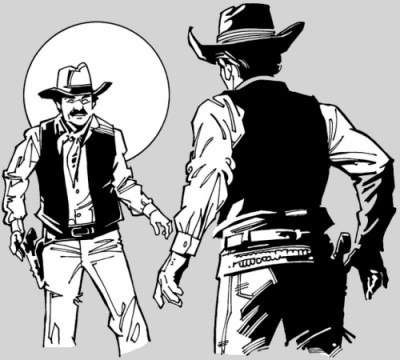 |
It
helps that Burzynski is media
savvy. Perhaps the
best thing that ever
happened to the man was when
filmmaker Eric Merola showed
up at his doorstep in 2008
and offered to help.
Since that time, Merola has
produced two documentaries
that do a persuasive job of
bolstering Burzynski's
reputation and counteracting
an ocean of negative disinformation
on the Internet.
However, ultimately, none of
this means a thing if
Burzynski's cure doesn't pan
out. Fortunately, it
appears that Burzynski has a
winner. He is far from
perfecting his cure, but
there is ample clinical and
anecdotal evidence to
suggest he is on to
something.
So far, Burzynski has
found a way to beat the
American Medical
Establishment at its own
game. No
wonder they are petrified of
the guy. Unless the
dark forces
find some way to stop him,
Burzynski might one day flip
the entire industry upside
down.
|
What
terrifies the Cancer Drug
Cartel the most is the fact
that Burzynski owns a
PATENT to his treatment.
That
patent symbolizes the stake
through the heart of the
vampire. If he wins, it becomes
lights out for the Game as it is
currently played.
Burzynski is dangerous
because he is poised to find
a cure for cancer and upset
the money train all at the
same time. He has to
be stopped at all costs or
else.
There
doesn't seem to be any
middle ground surrounding
this man. People
either believe in what he is
doing or absolutely detest
the guy and his work.
It takes about five seconds
of reading an article to
guess which side the writer
favors. For example, I
am sure you have guessed I
am on Burzynski's side.
No matter what side of the
fence you are on, after reading
this
story I am sure you will agree that the Medical
Establishment has gone to
extraordinary lengths to
shut him down.
So far
they
haven't succeeded. At
every turn, Burzynski seems
to give the Cancer Industry
a bitter taste of its own
medicine.
Now isn't
that ironic?
Paybacks are hell.
|
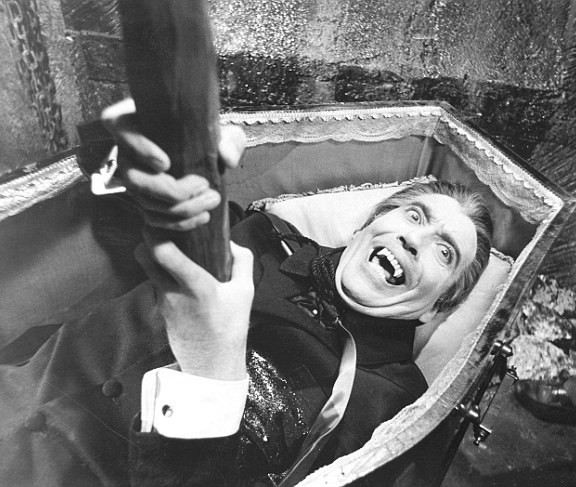 |
|
A Quick Look at
Stanislaw Burzynski
(from the Burzynski Clinic Web Site
located in Houston, Texas)
Stanislaw R. Burzynski, M.D.,
Ph.D., is a physician and
biochemist-researcher who pioneered
the development and use of
biologically active peptides in
diagnosing, preventing and treating
cancer.
In 1967, at the young age of 24,
S.R. Burzynski graduated from the
Medical Academy in Lublin, Poland,
with a M.D. degree with distinction,
finishing first in his class of 250.
During the same year he identified
naturally occurring peptides in the
human body which he concluded
control cancer growth. He found that
there is a marked deficiency of
these peptides in cancer patients.
The following year, 1968, he earned
his Ph.D. in Biochemistry as one of
the youngest candidates in Poland
ever to hold both an M.D. and Ph.D.
From 1970 to 1977, while a
researcher and Assistant Professor
at Baylor College of Medicine in
Houston, his research was sponsored
and partially funded by the National
Cancer Institute. At Baylor, he
authored and co-authored 16
publications, including 5 concerning
his research on peptides and their
effect on human cancer. Four of
these publications were also
co-authored by other doctors
associated with M.D. Anderson
Hospital and Tumor Institute, and
Baylor College of Medicine.
In May of 1977, Dr. Burzynski
received a Certificate of
Appreciation from Baylor College of
Medicine, commending him for
completing five years of dedicated
service and acknowledging his
contributions made to the
"Advancement of Medical Education,
Research, and Health Care."
That same year, Dr. Burzynski
founded his clinic in Houston where
he has since treated over 8,000
patients.
Read more
|
What
do the Detractors Say About
Burzynski?
If I were to
pick one word to describe the
naysayers, it would be 'virulent'.
The Internet criticism of Burzynski is
bitterly hostile and borderline
hateful.
All I can say
is there are two sides to every
story.
According
to Wikipedia, a whispering
campaign is a method of
persuasion in which damaging
rumors or innuendo are spread
about the target, while the
source of the rumors seeks to
avoid being detected while
spreading them (for example, a
political campaign might
distribute anonymous flyers
attacking the other candidate).
It is
generally considered unethical
in open societies, particularly
in matters of public policy. The
speed and anonymity of
communication made possible by
modern technologies like the
Internet has increased public
awareness of whisper campaigns
and their ability to succeed.
This phenomenon has also led to
the failure of whisper
campaigns, as those seeking to
prevent them are able to
publicize their existence much
more readily than in the past.
To date, there
have been two documentaries put out
about Burzynski. Both were
made by Eric Merola. In the
second documentary, Merola claimed
that the drug industry has gone to
the trouble of hiring people to
deliberately discredit Burzynski on
the Internet.
Merola states
that the drug industry has
orchestrated a group of "information
hit men" to pollute all channels of
public information in an effort to
confuse the public over the truth
about Burzynski. These people
engage in the intimidation and
harassment of prospective and
current terminal cancer patients
under Burzynski's care. By
masking the true sponsors of a
message (e.g. political,
advertising, or public relations),
these people give the appearance of
being a disinterested, grassroots
participant. In other words, by
withholding information about the
source's financial connection, this
increases the credibility of their
message.
Let's use
myself for example. Since my
message is sympathetic to Burzynski,
one might wonder if I am on his
payroll. After all, Burzynski
operates right here in my hometown
of Houston. Perhaps someone
got to me and persuaded me to write
something positive about the man.
Since I am a retired dance teacher,
on the surface I don't appear to
have any vested interest in
Burzynski. That gives me the
much-needed appearance of neutrality
and seemingly bolsters my
credibility.
Maybe someone
will ask what my motives are
for writing this extensive
article.
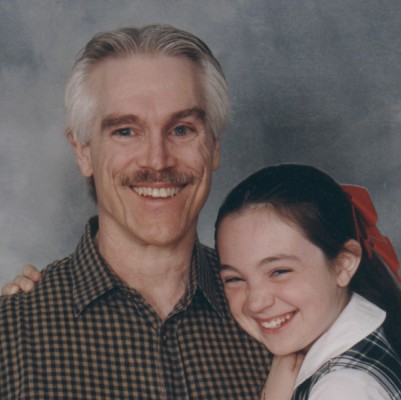 |
If I
am not being paid, then I
must truly believe in
Burzynski, right? But if it
turns out I am being paid or have a
hidden horse in the race, then my
word loses all value.
I will
save you the effort. For the
record, I am not being paid
a cent.
Got that?
No one approached me to
write this article about
Burzynski.
In
Chapter
One I documented what got me
started on this journey -
my daughter Sam's
Texas
4000 commitment, the sharp
2012 rebuke
from Mr. Skeptical, and the 2013 death
to cancer of
my brother in law Neil.
What I write here was
created by the anger I feel
over what I have learned in
my research of the cancer
industry.
|
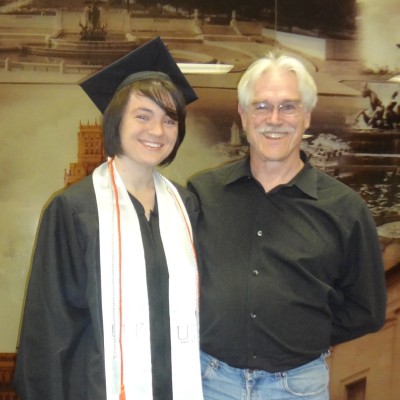 |
As for Eric Merola
and his opponents the Skeptics, I
will not tell you who to believe.
But I will say that if Merola's
claim is true, then this modern
Internet crusade against Burzynski
is reminiscent of Nixon's famous
"Dirty Tricks" campaign used to
smear his opponents. They
worked - ask Edmund Muskie. [
source ]
Or for that
matter, I remember the story of how
a rumor was spread before a 2000
South Carolina primary that John
McCain had fathered a black baby.
The trick worked - McCain had been
the frontrunner until that story
broke. [
source ]
Some will say
the famous Swift Boat ads used to
destroy John Kerry was also a smear
campaign. That devastating ad
campaign turned a close election
into a rout. [
source ]
Whatever the
truth, there can be no doubt the
political fortunes of Muskie, McCain
and Kerry took an immediate
nosedive.
Disinformation
campaigns are very powerful and very
difficult to counteract. I cannot
prove or disprove Eric Merola's
claim, but I can say the negative information
he refers to is extremely damaging to Burzynski's reputation.
Although
medicine is finally getting the
upper hand in certain cancers,
generally when it comes to Cancer,
almost everyone dies within five
years. As a result, one has to
learn to get excited when anyone
claims to "save" even one person in
five. Since so many people die
no matter what the treatment, it is
impossible for people like me with
little medical experience to
ascertain which doctor or which
treatment is the most effective.
Consequently,
with all these dead bodies, it is
pretty easy to use scare tactics to
destroy the reputation of any cancer
treatment.
Burzynski is
the perfect example. When I
first read the negative articles, my
confidence in Burzynski plummeted to
zero. In fact, I felt a
genuine contempt
for the man after reading what the
naysayers had printed. My
attitude changed later, but only
after a great deal of research.
Tell you what.
I will give you a taste of what I am
talking about.
|
Burzynski's
Wikipedia Profile
For starters, let's
visit our friend Wikipedia.
One hint - Wikipedia clearly does
not like this guy. No surprise
there. Burzynski doesn't even
rate a profile under his own name...
it was apparently deleted.
Instead, Wikipedia has substituted a
profile of his clinic.
I have offered
some of the highlights, but please be
advised
there's much more if you wish to
read it all.
Burzynski Wikipedia Listing
The Burzynski
Clinic offers unproven cancer
treatment.
The clinic is
best known for its "antineoplaston
therapy", a controversial
chemotherapy using compounds it
calls antineoplastons, devised
by the clinic's founder
Stanislaw Burzynski in the
1970s.
The clinic has been the focus of
much criticism due to the way
its unproven antineoplaston
therapy is promoted, the
exorbitant costs for cancer
sufferers participating in
"trials" of antineoplastons,
significant problems with the
way these trials are run, legal
cases brought as a result of the
sale of the therapy without
board approval, and for other
causes.
There is a scientific
consensus that antineoplaston
therapy is unproven and of
little promise in treating
cancer.
Clinical
trials initiated in 1993 and
sponsored by the National Cancer
Institute were closed due to
inability to recruit qualifying
patients, and a Mayo Clinic
study found no benefit from
antineoplaston treatment.
The Memorial
Sloan-Kettering Cancer Center
has stated: "Bottom Line:
There is no clear evidence to
support the anticancer effects
of antineoplastons in humans."
FDA warnings
Burzynski's use and advertising
of antineoplastons as an
unapproved cancer therapy were
deemed to be unlawful by the
U.S. FDA and the Texas Attorney
General, and limits on the sale
and advertising of the treatment
were imposed as a result.
2010 film, Burzynski – Cancer is
Serious Business
The 2010 film, Burzynski,
Cancer is Serious Business,
directed, written, edited, and
narrated by Eric Merola, an art
director of television
commercials, describes
Burzynski's use of
antineoplastons and his legal
clashes with government agencies
and regulators.
The Village Voice
commented that the movie
"violates every basic rule of
ethical filmmaking" and that by
interviewing only Burzynski's
supporters, the film's producer
"is either unusually credulous,
or doesn't understand the
difference between a documentary
and an advertisement".
Variety described the
film as having the qualities of
a "paranoid conspiracy theory"
and likened it to the National
Enquirer, adding that the film's
explanatory diagrams are
"simplistic to the point of
idiocy". The review concluded
that "despite its infotainment
look, Burzynski ultimately
proves convincing."
Houston Press correspondent
Craig Malisow mocked the film's
lack of objectivity,
characterizing it as "a
puff-piece paean that
cherrypicks facts and ignores
any criticism", and
criticized the project for
presenting only Burzynski's side
of the story.
Read More:
Burzynski Wikipedia Listing
Rick
Archer's Note: I found it
curious that the Wikipedia listing
saw fit to criticize the movie for
presenting 'only Burzynski's side
of the story' when Wikipedia
itself doesn't have
a clue about
presenting both
sides of any
alternative medical
issue.
This Wikipedia write-up made no
attempt whatsoever to present a
single
positive word about Burzynski. This is what
is known as a case of the pot calling
the kettle black.
Now let's read
some of the many 'less than
complimentary' comments that can
be found on the Internet. They
are not hard to find. I got
each of these from Page One of
Google.
Put your seat belts
on; things are going
to get rough.
|
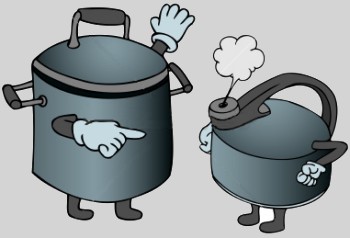 |
|
|
Stanislaw
Burzynski and the Antineoplaston
Scam
By Bob Blaskiewicz
from
Skeptical Humanities
November 10, 2012
Over 10 years ago, a friend of
mine whose son had spent the
better part of the past year
fighting a brain tumor called me
and said that her boy was too
sick to be included in an
experimental trial at St.
Jude’s. She was truly
disconsolate and desperate. She
told me that she had heard of a
doctor “out West” who was
treating cancer patients with an
extract of human urine and was
reported to have cured all sorts
of cancers. With a very heavy
heart I had to destroy the last
hope for a cure for her son; if
he had really cured cancer, he
would have multiple Nobel Prizes
for curing one of man’s most
universally feared scourges. She
was devastated, but she saved
her son the trial of a last long
trip, and he died peacefully at
home a few weeks later, which I
guess is worth something.
I never forgave that doctor for
putting me in that position, and
only last year I found out who
he was. His name is Stanislaw
Burzynski. He works out of his
clinic in Houston. He is the
discoverer, manufacturer,
prescriber, and dispenser of
what he calls “antineoplastons”
(ANP), which he first extracted
from human urine in the 1970s
but now produces synthetically.
I learned his name because an
occasional employee of his had
sent legalistic threats to
bloggers who questioned the
validity of his treatments,
which he has given for over 30
years under the guise of
“clinical testing” with
staggeringly unpromising
results. What brought Burzynski
back to the attention of the
blogosphere was the way that
Burzynski’s shill and occasional
hired help, Marc Stephens, not
only threatened teenageer Rhys
Morgan’s family with legal
action but also sent them a
picture of their house, the
unmistakable message “we know
where you live.”
Despite the thuggery of some of
his supporters (which included
the creation of a website at the
same IP as
burzynskipatientgroup.org that
defamed numerous skeptics,
myself included, as pederasts),
his decades-long failure to
produce a single convincing
study about ANP’s efficacy, and
the fact that his medical
license is under review for a
host of alleged ethical
violations, including “the
failure to meet the standard of
care, negligance, lack of
informed consent, unprofessional
conduct, and nontheraputic
prescribing,” Burzynski
continues to practice. The
aggravating factors applied to
the Texas Medical Board’s
lawsuit include:
1 Harm to one or more patients;
2 Economic harm to any
individual or entity and the
severity of such harm;
3 Severity of patient harm;
4 One or more violations that
involve more than one patient;
increased potential harm to the
public;
5 Intentional, premeditated,
knowing, or grossly negligent
act constituting a violation;
and
6 Prior similar violations.
(Source: casewatch.org)
From the position of an informed
patient advocate, everything
about the Burzynski Clinic reeks
of medical charlatanry. He is
not a trained oncologist, but he
is treating cancer. He posits a
novel mechanism for cancer (a
patient’s lack of
antineoplastons) that is
unrecognized in the medical
literature as a cause. His ANP
is marketed as an alternative to
chemotherapy, but he gives
patients chemo cocktails mixed
with “terrifying” doses of
sodium phenylbutyrate, mixtures
that have not been adequately
tested for safety and which
causes hypernatremia in his
patients.
He has
sold ANP not only as a cancer
treatment, but also as an HIV
treatment, an unjustified action
for which he was severely
disciplined by the Texas Medical
Board. Checks for donations that
are meant to go “toward the
continuation of the Clinical
Trials and Research” are to be
made out directly to “S.R.
Burzynski, M.D., Ph.D.” He has
initiated over 60 phase II
studies over the decades and
seems to have completed exactly
zero of them. Three independent
investigations, published
together in The Cancer Letter,
concluded that his studies were
“uninterpretable,” and that
Burzynski defined successful
treatment as “stable disease,” a
lowered standard that no other
oncologist or researcher
accepts.
An important sign of quackery is
the depiction of the doctor as a
lone genius fighting against
special interests trying to
suppress crusading work. This
is, of course, bunk. What is
routinely cited as evidence of a
vast conspiracy against
Burzynski is the routine
prosecution of a run of the mill
repeat offender. Nonetheless
saying that he has sinister
forces arrayed against him gives
Burzynski an excuse to never
produce evidence of efficacy
that could be tested by an
outside group.
There is something distinctly
aberrant about Burzynksi’s
supporter base, and a cult of
personality surrounds the man
unlike anything that I have seen
in other medical schemes. At the
root of cults is a psychological
dependence on the leader, and
Burzynski’s cult nurtures his
patients’ dependence on him by
making them fear and distrust
modern medicine, stripping away
desperately ill patients’ hope
in legitimate, tested therapies
and substituting them with his
“treatment”.
Abominable.
Bob
Blaskiewicz
Read more
|
Comments from Science-Based
Medicine (David
Gorski)
FastBuckArtist
June 10, 2013
In the
interviews with parents of the
patients it becomes very clear
why people choose Burzynski –
he’s the only person who offered
them some hope while
conventional oncology offered
them to wait while the child
dies.
This is a failure of oncology
counseling. Why were these
patients not offered
participation in the many
ongoing clinical trials for
brain tumors?
The BBC program is a free
advertisement for the Burzynski
clinic. Gorski might find it
balanced, but a cancer patient
watching this program will hear
one thing only – someone in
Texas is offering a cure for his
kids cancer.
elburto
June 10, 2013
A cure? Well I suppose if you’re
dead then cancer’s no longer a
problem. So
yeah then, Count
Scamula’s curing them. Of life.
mdcatdad
June 10, 2013
The
disadvantages of an oncologist’s
honesty in the face of
Burzynski’s feel-good patter is
encapsulated in this exchange I
read years ago between Polish
(presumably atheist) Communist
leaders observing a Catholic
funeral:
“Those
damn priests have an
advantage over us: they can
promise their people eternal
life.
All we can do is wave
goodbye”.
Read More
|
THE DEATH CHART
Rick Archer's
Note:
Bob
Blaskiewicz, the man who
wrote one of the reviews above, was
also kind enough to create a
web site listing the names
of the people who have died
under Burzynski's care.
Blaskiewicz death
chart
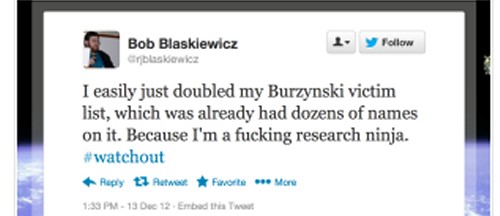
|
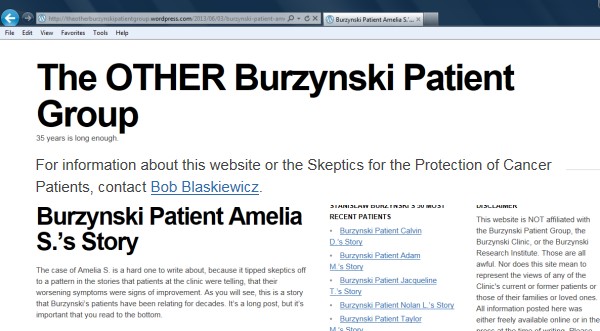 |
For this chapter, I
made a conscious
decision to avoid
defending the
"efficacy"
(effectiveness) of
Burzynski's
treatment.
Since I am not a
physician nor do I
have any first-hand
knowledge, I have no
business making any
statements
about "how good" the
treatment is.
That said, if you
want my honest
opinion, I will
simply say that if I
were unlucky enough
to be diagnosed with
cancer, I would make
an appointment with
Burzynski. Let's
leave it at that.
There is a very grim
thing one has to
understand about
cancer treatment...
depending on how
serious the illness
is, almost everyone
dies no matter what
the treatment.
And that includes
many of Burzynski's
patients as well.
This grim reality
assures Bob
Blaskiewicz that he
will have a field
day finding names to
add to his Burzynski
Death Chart.
These kind of scare
tactics are very
effective. My
wife took one look
at Blaskiewicz's
Death Chart and
stopped reading my
article at this
exact point.
Why? Because
reading about cancer
is very depressing
and that death list
hits right on top of
a very raw nerve.
Most people would
rather not even
think about cancer,
much less the death
rate. I don't
blame them one bit.
|
STATISTICS
What separates
Burzynski from the
others is that
SOME of his
patients live while
practically no one
lives with
conventional
treatment methods.
These charts were taken
from the first
Burzynski
documentary. The
first chart shows that Burzynski's batting
average was 25%
while conventional
treatment was only 9%.
The second chart
shows that
Burzynski's batting
average was 28%
while the
established
treatment records
showed that not a
single person lived
past five years.
The
reason that Burzynski terrifies the Medical
Establishment is that even his so-so batting record
FAR SURPASSES conventional cancer treatments.
Until Burzynski came along, NO ONE survived these
types of cancer. Burzynski doesn't cure
everyone, but he does cure a few. That
suggests that he really is on to something. With
time maybe he will do even better.
There is another important angle. While
conventional chemo-radiation-surgery cancer treatment causes overwhelming
ADDED SUFFERING, Burzynski's treatment seems to be
harmless to the body. It causes no
suffering and no further damage to the body. No one
suffers due to antineoplastons.
Unfortunately, the Burzynski treatment is at best a
possibility, not a sure thing. You risk
spending $100,000 hoping you might be one of the
lucky ones... 1 in 3, 1 in 4, 1 in 5?
It is
easy for us to dismiss those odds until it becomes
our turn. When one is dying or the victim is a loved one, then
the temptation to roll the dice becomes
overwhelming.
No one
ever claimed cancer was fun. We all know it is
an ugly nasty gruesome business. The good news in
cancer treatment is few and far between.
Some live, most die.
|
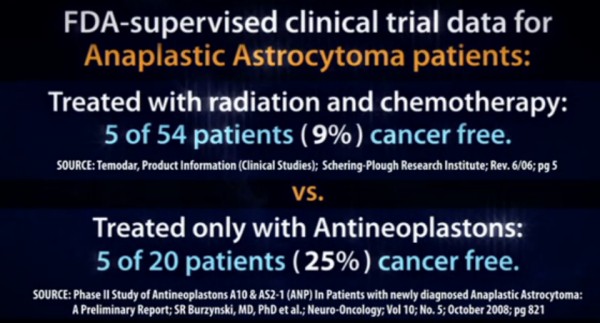
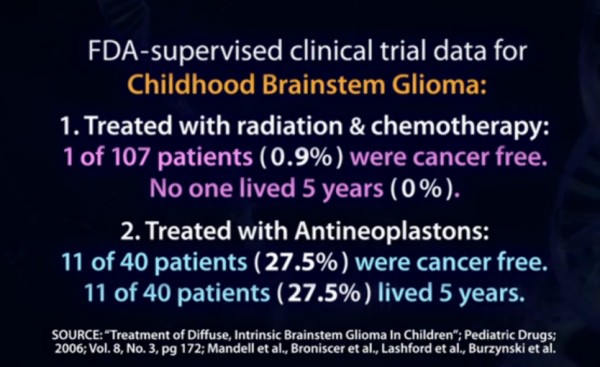 |
While you or I might
dismiss 25% as a
pathetic result,
people who are in
the cancer field are
actually AMAZED by
that statistic.
For example, Dr. Nicholas Patronas of
the National Cancer
Institute was
particularly impressed with Burzynski's work. Patronas stated:
"So these
particular individuals not only survived, but they
didn't have major side effects. So I think it is
impressive and unbelievable."
Another researcher,
Dr. Robert
Burdick, agreed
with Dr. Patronas
that Burzynski's
treatment had great
value.
"Thus the
response rate here is an astounding
33%, with
a complete
remission rate of 15%.
Such remission rates are far in
excess of anything I or anyone else has seen since
research work on brain tumors began.
It is very
clear that the
responses here
are due to
antineoplaston
therapy and
are NOT
due to surgery,
radiation or
standard
chemotherapy."
|
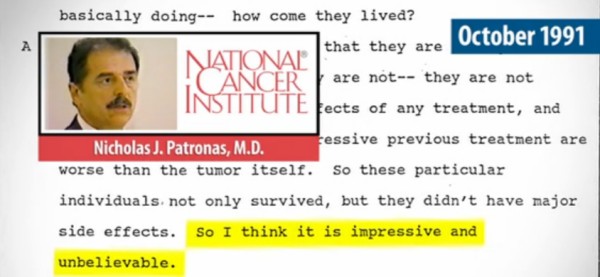
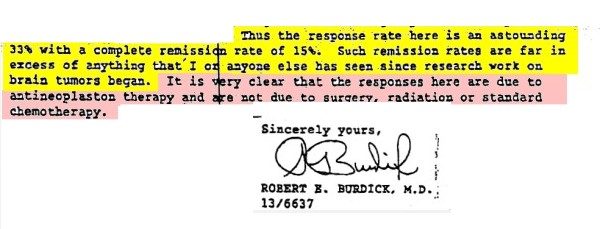 |
|
|
|
|
The Burdick
Report
|
In 1995,
Burzynski was indicted by a Grand Jury. His
story is covered later in this article.
At the
time, Robert
Burdick, MD, a Seattle oncologist and faculty member of
the University of Washington Medical School,
was asked to review Burzynski's
work.
Burdick
analyzed the results of some of these patients
Dr.
Burdick took the time to examine the case records of
17 Burzynski patients
in preparation for Burzynski's 1997 Grand Jury
trial.
Burdick
then sent a report of his findings to Sim Lake, the
judge. You can
view the entire document on the Internet here:
source I
However,
since this
report is seven pages long, for the sake of
brevity, I have included just these excepts below.
|

|
"It is very rare,
currently, to ever get a complete remission or cure
in a patient who has a malignant brain tumor, using
our standard modalities of surgery, radiation and
chemotherapy…"
"As a rough estimate,
neurosurgeons do well to cure one in every 1,000
brain-cancer patients they operate on. Radiation
therapy slows the growth of adult tumors, gaining
perhaps one month of life, and again may result in a
cure in only one in 500-1,000 patients…"
"Similarly chemotherapy
research, despite 30 years of clinical trials, has
not resulted in the development of a single drug or
drug combination that elicits more than an
occasional transient response in primary brain
tumors…"
(Note:
Burdick then goes on make a detailed report on
17 different Burzynski patients that he
studied.)
CONCLUSION
ON FINAL PAGE
"The responses (with
Burzynski's treatment) are far in excess of any
prior series of patients published in the medical
literature…"
"Thus the response rate here is an astounding
33%, with
a complete
remission rate of 15%.
Such remission rates are far in
excess of anything I or anyone else has seen since
research work on brain tumors began."
It is very clear that the responses here are due
to antineoplaston therapy and are NOT
due to surgery, radiation or standard
chemotherapy."
You can view the entire document on the
Internet here:
[
source I ]
|
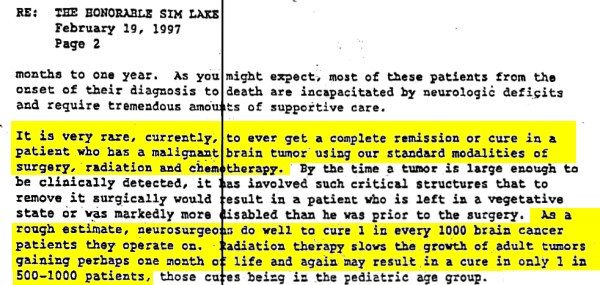

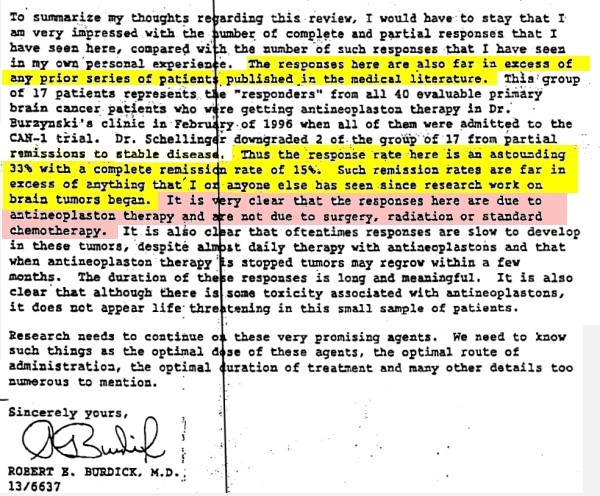 |
|
|
|
Rick
Archer's Journey with Burzynski
|
So why did I write about
Burzynski?
Although Dr.
Burzynski's clinic is here in Houston, my hometown, I have never met the man
nor do I know anyone who knows him personally.
Furthermore I have never read about him in the local
newspaper nor heard about him on television.
His story came as a
complete surprise to me in the past few months (June 2013) when I
began researching the Internet for my Cancer Diaries article.
In my
previous chapter, I pointed out
that the Forbidden Cures Documentary had upset me so much
that I decided to visit the Internet to research the stories told in the video.
I wanted to ascertain for myself as much of the truth as I could.
During my Internet research of Gerson, Caisse
and Hoxsey, Burzynski's name popped up from time to time.
However, so did Coley's Toxins, Royal Rife, Ernest Krebs,
Luigi di Bella, Issels Treatment, and Johanna Budwig. The only
thing I noticed to separate Burzynski from this group was that
Burzynski was obviously hated worst than the rest.
However, writing my
stories had taken its toll on me. I walked around in a
perpetual funk. Reading about cancer is about as depressing a
topic I can think of short of studying the Holocaust.
I have taken each new
step on my journey with extreme reluctance. The stories of
Gerson, Caisse and Hoxsey were all I needed to convince me something
was deeply wrong in the cancer industry. After I finished
writing about them in Chapter Two,
I wanted to exit the cancer swamp and move on to something else.
|
 |
As far as I was
concerned, the less I knew about Burzynski, the better.
I had just
finished writing my article on Max Gerson and I was grouchy. It
was time to wrap up this cancer article and go back to my
happy life of jitterbug dancing, jigsaw puzzles, Stephen Colbert and history
documentaries.
Then my
conscience kicked in. I became aware there was some sort of video
out there about Burzynski. Maybe I should watch that video.
I groaned when I noticed the damn Burzynski video was two hours long. No
way. I had about ten minutes of patience left, but
definitely not two hours.
I was sick of writing about cancer!!
Just thinking
about the disease put me a really bad mood. The
Forbidden Cures Documentary had been bad enough.
Consequently I
did not want to invest two more hours watching another depressing
cancer video.
So I skipped the
Burzynski video. I had reached my limit.
However, I
immediately got that nagging feeling I had done the wrong thing.
But I didn't have the energy for two hours. So my
conscience looked for a compromise. That little
small voice in the back of my mind suggested maybe I should
AT LEAST READ some of what the Internet said about Burzynski.
So I typed "Burzynski"
into Google. OMG! Let me
tell you, it was scathing! It was the Gorski and
Blaskiewicz criticism I posted above. Ugh.
Gorski and
Blaskiewicz weren't the only ones. There was an army
of naysayers. The first three pages of Google were full of
Burzynski vitriol. It is unbelievable how they hate
this guy! I read some of the negative reviews about the man
and shook my head in disgust. Not only was Burzynski
hated worst than the rest, his treatment cost a lot of
money. This was money that would not be reimbursed by
insurance. Furthermore, most of his patients died and
he had some awful cure derived from human urine. Talk
about quack! After reading these guys, I figured no
one would dream of throwing $100,000 down the drain just to
be filled with urine extract and surely die anyway.
This guy had to be the worst ever.
I was ready to check out right then and there... just like
my wife did when she read the BURZYNSKI DEATH CHART compiled
by Blaskiewicz.
After reading
that stuff, I was so disgusted that I really didn't want to
know anything more about the man. Based on all
those nasty comments, I was ready to write Burzynski
off. Then I noticed on Page 4 of Google that Burzynski had been interviewed by Dr. Mehmet Oz.
Doctor Oz? Is
that the same man with the goofy name that my wife watches
on TV every day? Sure enough, same guy.
Dr. Oz happens
to be a man I respect. Furthermore my wife Marla
agrees. She considers him to be a man of high integrity as well as
someone who shares important information. Marla told
me she gets the impression Dr. Oz can be unconventional at
times and that she likes his open-minded quality.
Before looking
at the Burzynski-Oz interview, I decided to read up on Dr.
Oz first. Hmm. I laughed when I realized that
"Oz"
was his real name. I figured he made it up for TV.
Then I noticed that Dr.
Oz
definitely has credentials. Dr. Oz is
a very bright guy... Harvard undergrad, MD from the University
of Pennsylvania, MBA from the Wharton School.
He also has enough
talent to conduct two full-time careers at once. When he isn't
busy taping his two-time Emmy-awarded medical TV show, Dr. Oz is a
top-flight heart surgeon affiliated with Columbia University in New
York. Impressive.
So I gave in to
my conscience. Okay. This
is it. I will take this one last step.
Let's see what Dr. Oz has to say about Stanislaw Burzynski.
|
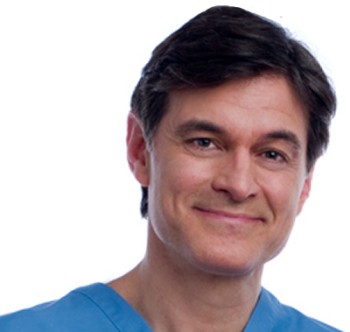 |
|
Mehmet Oz
Interviews Dr. Burzynski
I groaned when I
found out it was not an newspaper article or a Youtube
video. It was a radio show. Furthermore I could find no
written transcript. Darn it. I didn't want to
listen; I just wanted to read. Oh well. If I was
going to do this, I had no choice but to
listen.
I saw that I had
two choices: 10 minutes on
Oprah Radio or 37 minutes on
Youtube.
As tired as I was with the subject of cancer, I chose the 10 minute version.
I smiled
hopefully. In 10 minutes, I could be done with the subject
of cancer and get on with my life. All I needed was a
single discouraging word about Burzynski from Oz and I'm outta
here.
Once I began to
listen, I realized this 10-minute condensed
version was taken from the middle part of a three part
Interview. Like coming into a movie half-way, I was lost. What I did gather was that Dr. Oz didn't know much
more about Burzynski than I did. He kept asking
questions in a way that suggested Oz did not actually know the answer
ahead of time. This interview wasn't
rehearsed.
I got the
impression
that Dr. Oz was interested in Dr. Burzynski's work, but not
totally convinced. Dr. Oz implied that he had
little insight into what Burzynski was doing because there wasn't
much medical information about Burzynski being published.
Dr. Oz said that Burzynski is pretty much a mystery to most
practicing physicians. He then included himself in that
category.
I wasn't
terribly impressed by the 10-minute interview. When Burzynski spoke, his English was so garbled I didn't
understand much of what he was talking about.
Then something
got my attention. Dr. Oz said he was very impressed by
Eric Merola's
Burzynski documentary.
Dr. Oz said the
Burzynski Documentary is what raised his curiosity in the
first place.
That made me
think. Hmm, Oz says this is an interesting documentary.
Got it.
Dr. Oz made me
laugh when he openly admitted his mother-in-law had bullied
him into watching the Burzynski documentary. It
turned out to be a double-team. After viewing the
documentary, his wife Lisa saw her advantage and strong-armed Oz into conducting
the radio interview... which Lisa also participated in.
|
In other words,
the mother-in-law set him up and the wife
finished him off. I found it amusing to
learn that high-powered doctors have the same Achilles Heel
as I do - a smart and persuasive wife.
With a smile on
my face, I decided to study the Internet reaction to the
Oz-Burzynski interview. Someone should have warned me.
I was stunned by the anger!
Scanning the Internet, I could not help but notice
how bitter people were that Dr. Oz would lend his ample
credibility to Burzynski's name. The picture on the
right will establish that fact.
I was interested
in the extent of the negative reaction. I realized I
was actually more curious about Dr. Oz than Dr. Burzynski. What did Wikipedia have to say about Oz?
Would it punish the doctor for his
impudence in supporting this cancer renegade?
Nothing was said
about the interview. Wikipedia gave Oz, "America's
Doctor", little more
than a rap across his knuckles. Perhaps due to his
popularity, the only criticism was
a generalized sniff at his support for Alternative Medicine:
Oz is a
supporter of integrative medicine, combining
conventional medical treatments with alternative
therapies such as hypnosis, prayer, energy healing, and
homeopathy. Oz's wife, Lisa, is described as a
master of Reiki, a form of energy healing.
Some
conventional medical practitioners allege that Oz is
promoting unproven and harmful alternative medicine
practices on The Oprah Winfrey Show and elsewhere.
|
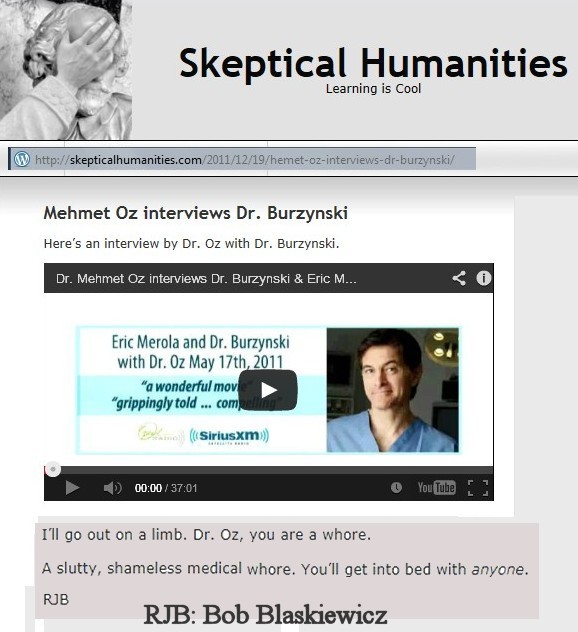 |
From what little
I heard in the radio interview, I gathered a major
problem with Burzynski is that no one in the
conventional medical field will touch him. This man is
so controversial that no one with a reputation to protect
will say much of anything positive about him. We only
hear from the critics... and their roar is deafening.
|
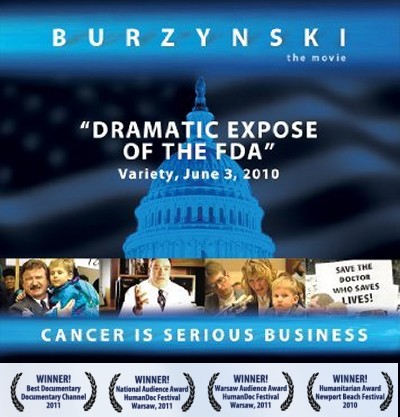 |
But now
Burzynski had at least one ally - the dapper Doctor Oz.
Oz had stuck his neck out far enough to give Burzynski
half a thumb up and the documentary a full thumb up.
I was reminded
of the time I was about to dismiss Max Gerson until I read
that Albert Schweitzer believed Gerson was "the most eminent
physician of his generation".
Interesting
coincidence.
Mehmet Oz had just done a
similar favor for Burzynski.
Okay.
With a sigh, I decided to break down and watch the Burzynski
Documentary. If Dr. Oz can survive watching it, so can I.
Good move. I was absolutely
stunned. The documentary told a story so unbelievable I still have
trouble believing it is true. It told a tale of
corruption on a scale I never thought possible here in
America. You should watch
it yourself. It is free on the Internet to anyone who
is interested.
Burzynski Documentary I
When I finished
watching the documentary, I
decided it was time to share the story of Stanislaw
Burzynski in my Cancer Diaries.
|
Before We Begin...
Dr. Burzynski has led a
fascinating and quite complicated life. In a career that spans
40 years, there are enough twists and turns to write a whole book
about him. However, not everyone has the patience to read an
entire book, so I will condense the story as best I can into one long
chapter and show the reader where you can go if you wish to learn
more.
My story draws from
material found in six different places.
Michael Lerner, Commonweal
The
first source came from a website known as
Commonweal, an institute
co-founded by Michael Lerner.
On the
Commonweal website, one can read
Michael Lerner's book on cancer
research in its entirely. The
title is:
Choices
In Healing: Integrating The Best of Conventional and
Complementary Approaches to Cancer
Lerner wrote
an entire chapter on Burzynski (Chapter
21). In addition to
interviewing Burzynski personally,
Lerner drew on several passages
written by Ralph Moss in his
ground-breaking book
The
Cancer Industry (Ralph W.
Moss, New York: Paragon House, 1989).
If you are
looking for an intelligent, middle
of the road, penetrating look at
Burzysnki, start here. Lerner
is not a hater nor is he a true
believer. No matter what you
think about Burzynski, you cannot
help but be impressed by the quality
of the writing in Lerner's Chapter
21.
I have a very simple
suggestion. If you are
interested a lot about Burzynski
quickly, skip everything else and
read
Lerner's account
first.
The only downside is that the information appears to stop
around 1991. A lot has
happened since then.
|
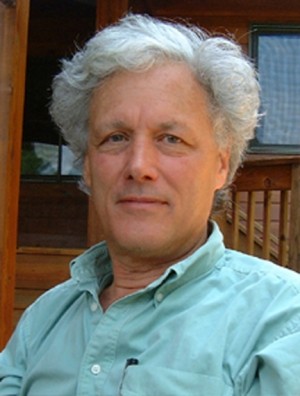 |
Gavin Phillips
Gavin Phillips
has a web site titled
Cancerinform.
Mr. Phillips
conducted a lengthy
2003 interview
phone
interview with Dr. Burzynski that I
found quite useful. This is
the best source of information that
I ran across about Burzynski during
the 2000s.
|
James
Van Maanen and Eric Merola
James Van
Maanen has a website titled Trust
Movies.
I found two
excellent interviews on Trustmovies
between James Van Maanen and Eric
Merola. Merola, of course, is the maker of two
film documentaries about Burzynski.
After completing each documentary,
Eric Merola made himself available
as a spokesperson for Burzynski.
The conversations between Merola and
Van Maanen were just as interesting
as the documentaries themselves.
Interview: Documentary Part One
Interview: Documentary Part Two
|
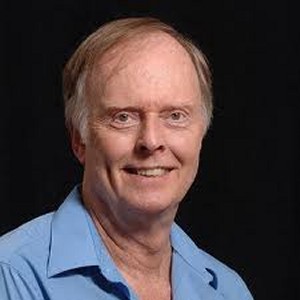 |
Jeb
Stuber and Thomas Elias
I found a wealth of
information at
samaritanministries.org posted by Jed Stuber.
From what I gather, Mr.
Stuber relied heavily on information from a book titled The
Burzynski Breakthrough written by Thomas Elias.
Amazon
Review of Elias' book written by
Judith Katz
(New York, NY, USA)
|
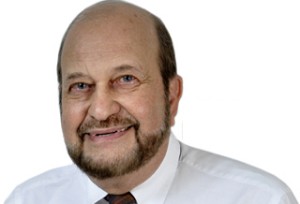 |
This
review
is from: The Burzynski Breakthrough
I picked up Thomas Elias's book with a skeptical mindset and
came away utterly convinced that Dr. Burzynski is the real
thing: a dedicated scientist and researcher who has discovered a
powerful nontoxic therapy for cancer. Instead of honors and
awards for saving lives, a status that is just now, finally,
accruing to him, the doctor attracted animosity and worse from
vested interests in the cancer "industry." His offices were
raided, and he was threatened with imprisonment.
As Elias clearly
describes in his beautifully rendered style, years of
persecution became decades. Meanwhile, there was one group
solidly behind Dr. Burzynski: his patients!
These were people
who had been given up on by conventional medicine --men, women
and especially young children, with aggressive, often end-stage
brain tumors and other cancers. Dr. Burzynski treated them with
his antineoplastons, they lived, in most cases even thrived,
and, shockingly, their doctors had one word to say: "Remission."
Over and over again, this same denial by doctors cropped up, as
people were told that what they could plainly see, feel and
touch was not reality. But how could anyone deny obvious
long-term remissions, cures, and good quality of life people
experienced from Dr. Burzynski's medicine, as Elias faithfully
reported!
After I read this book the first time, I went to the patient
website that Elias described, [...] Now I know why these past
and present patients, or patient family members, adore this man
and will do anything to keep him out of harm's way. He has saved
their lives! Someday he may be called upon to save yours. If
that time comes, I hope you will have read this book. Bravo Tom
Elias! And bravo to Dr. Burzynski, for his remarkable work.
Slowly but surely (and this gives me hope for a cancer-free
world, someday) the rest of the cancer establishment is catching
up with this intrepid pioneer.
If I or anyone I care about would ever develop any form of
cancer, God forbid, I can tell you that I will be on an airplane
to Dr. Burzynski's clinic in Houston the same day. I know what
chemo and radiation do to the body. And now, thanks to Tom
Elias, I also know there is an infinitely better, natural
treatment where the cure will not kill you. This, to me, is
comforting beyond belief.
I have bought this
book for everyone I know.
|
Eric
Merola's Transcript
My fifth
source was Eric Merola's transcript.
Eric Merola is the maker of two film
documentaries about Burzynski. One
of the unusual features of the first
Burzynski documentary is that the
entire movie has a written
transcript of all 10
Chapters of the movie. For
purposes of creating my story, I
found it very useful to watch the
video on one screen and follow the
transcript on another screen.
Frequently I would simply cut and
paste their own narration into my
own story.
In his second
interview with James Van Maanen of
Trust Movies, Merola commented on
his parallel transcript:
"The entire film - Part I - is
backed up and sourced for
transparent fact-checking by
anyone. That includes the patent
situation. Every document used
in the film is available - in
context - for anyone to
scrutinize and fact-check for
themselves. I knew I had to back
up everything in this
documentary since most people
would find corruption of this
magnitude simply too hard to
believe at face value."
Transcript of First Burzynski
Documentary
|
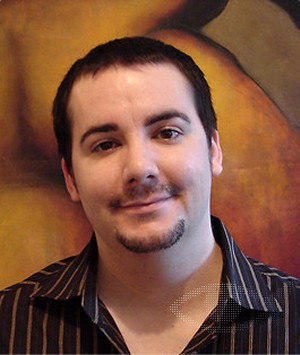 |
The
First Burzynski
Documentary - Cancer is a Serious Business
My sixth source
was the Documentary
itself. The film detailed in gory, ugly
detail how all kinds of institutions - the Texas Medical
Board, the FDA, the National Cancer Institute, and Big Pharma
- lined up to take Burzynski down... only to see Burzynski
win in the end.
I
wish to remind everyone that this
movie is posted on the Internet
for anyone to view themselves
free of charge.
In
the following story, you don't have to
take my word on anything I have written.
You can go to the Documentary and watch
the very thing I am reporting on with
your own eyes.
Burzynski Documentary Part One
|
 |
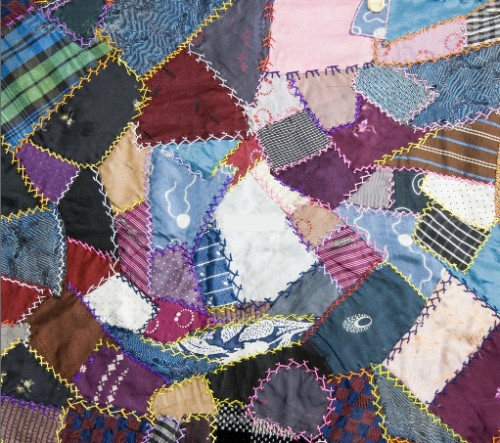 |
After drawing on the work of six
different sources, I fully admit my
story about Stanislaw Burzynski
resembles a crazy patchwork quilt.
That said, you
have my word I did the best I could
to synthesize the different angles
into a somewhat coherent narrative.
As you will
see, I spent most of my energy
concentrating on the politics.
To explain the
treatment itself is far too
complicated for this story nor do I
have the medical background to lend
any insight.
What I can say
is that Eric Merola's SECOND
DOCUMENTARY about Burzynski
concentrated primarily on the
treatment itself.
The second
documentary is not available for
free viewing, so I purchased a copy
for $14. I can only speak for
myself, but after the personal
testimony of several of Burzynski's
patients, I came away from the
SECOND DOCUMENTARY completely
convinced that Burzynski is on the
right track.
Rick Archer
August 2013
|
|
The
Saga of Stanislaw Burzynski
|
Forward
Much of the early part
of this story is drawn from The Burzynski Breakthrough,
written by Thomas Elias. Elias believes that the U.S.
government and the pharmaceutical industry have for decades used all the
means at their disposal to quash the most promising cancer treatment
in the world.
If this story sounds
far-fetched, consider Elias’s background. After taking a
master’s degree from Stanford, Elias was the West coast editor for
Howard Scripps news service for 15 years. His syndicated columns now
appear in 70 newspapers.
Elias is a veteran
journalist with a nose for a story. He questions everything. When he
first heard about Burzynski, he wanted nothing to do with the story.
Elias explains, “As a
reporter, I had been confronted on a regular basis by cranks
claiming to have unique or scandalous stories. They virtually never
pan out.”
Burzynski’s patients
prevailed upon him though, and so Elias took another look and did a
few stories.
He says he has published millions of words in his lifetime, but
only two topics have ever compelled him to make sure a full book
length treatment got into the public record: the O.J. Simpson trial
and Dr. Stanislov Burzynski’s antineoplaston treatment for cancer.
|
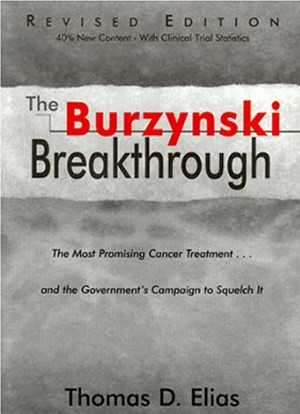 |
Burzynski’s Background
Stanislaw
Burzynski was born in 1943 in
Lublin, Poland which was occupied by
the Nazis during World War II and
quickly turned communist in the
years after the war. His
father was harassed and jailed for
teaching Jews, and his older
brother, Zygmunt, joined the
resistance and died from a gunshot
wound. Young Stan always
excelled in academic pursuits,
especially science, and upon
graduation from secondary school he
was sent to medical school.
Burzynski
became an assistant to biochemist
researchers working in the
developing field of chromatography,
which used chemicals to produce
colors that determine the molecular
structure of a substance. They
were researching peptides, a
class of very small molecules which
are building blocks for larger
molecules such amino acids and
proteins. [Peptides are chains of
Amino Acids, so if you put together
2 Amino Acids, you have a Peptide.]
Burzynski’s
teachers mostly yawned. They were interested in
agricultural applications, basically
anything with the potential to develop better food
supplies. However Burzynski was
undeterred. While it was assumed that
these classes of molecules also had
important functions in the body,
exactly what those functions were
was still being worked out, and in
fact is still being researched to
this day as the biochemistry of the
human body continues to amaze
scientists.
Burzynski had
a natural talent for isolating the
peptides using the tricky art of
chromatography and had soon
identified 39 substances that seemed
to be uncatalogued. He’d later learn
that some British researchers had
noted a few of them, but nobody
seemed to think these particular
ones were significant, or worth
studying further.
Burzynski
needed an interesting topic for his
doctoral thesis, so he kept working
on the peptides. One day he
noticed that certain particular
peptides appeared less frequently in
the blood and urine of cancer
patients. This fortuitous
observation got him thinking.
What would
happen if he put these same missing
peptides back in the blood of cancer
patients?
He surmised that giving them to
cancer patients might help them.
And if so, why was it helping?
These two questions intrigued him.
Burzynski was determined to explore the
possibilities, not then
understanding that this quest would
become a calling and a lifelong
battle with the medical
establishment and government
authorities.
Burzynski
was one of the two youngest people
in Poland to receive M.D. and Ph.D.
degrees. He was recruited by the
communist party and promised a
prestigious university position, but
he turned it down. Authorities
then sought
to quash his independence by
drafting him into the army to be
sent to North Vietnam to aid the
Vietcong, the fate of many Polish
doctors.
An influential
Polish scientist intervened;
Burzynski mysteriously received a
passport, which was nearly
impossible to get. He left Poland
hastily and the military police
showed up at his home hours later.
He carried just $20 and
documentation about the peptides,
arriving in New York in the fall of
1970.
Developing Antineoplastons
Upon arriving
in the United States, it took
Burzynski six weeks to land a job in
Houston at Baylor College of
Medicine. This research
center in those days was receiving
large grants for its pioneering
research in anesthesiology and heart
transplants. Some of the money also
funded research on peptides effects
on the brain and memory. Baylor had
some of the best equipment in the
world for chromatography.
Burzynski’s expertise was welcomed,
and he worked out an agreement where
he was allowed to spend half his
time working on the peptides he’d
discovered.
With a more
sophisticated laboratory, Burzynski
now was able to break down the substances
even more precisely into 119
different molecules. The nearby
MD Anderson cancer center had
just begun receiving huge infusions
of federal funding, and Burzynski
managed to work out an arrangement
with colleagues there to
test the peptides on cancer cells
grown in labs. Sure enough, they
found a few that shrunk tumors.
Burzynski began publishing the
results in medical journals.
In these early
years of research he met his wife,
Barbara, a fellow Polish immigrant
and medical doctor. They have been
inseparable since, and occupy side
by side offices to this day.
When President
Nixon announced a “war on cancer”,
Burzynski applied for a grant from
the National Cancer Institute.
With the help of influential allies
at M.D. Anderson, his research was
funded from 1974-1977. His
understanding of the substances was
refined, and he saw anti-cancer
properties with some, while
eliminating others. An experiment on
breast cancer cells produced very
promising results. Then he found
a few peptides that seemed to work
on every kind of cancer cell they
encountered. He and his colleagues
continued to publish results.
They
were becoming convinced that the
body had its own biochemical defense
system against cancer.
A small group
of polypeptides seemed to act as
controllers that could simply turn
off the malignant growth of cancer
cells. Burzynski dubbed them
antineoplastons because “neoplasia,”
the Greek word meaning “new growth,”
was the technical term for cancer.
Those were the
days when Burzynski was the fair-haired boy of cancer
research. His work on peptides had everyone excited.
He was on friendly terms with the top researchers over at MD
Anderson and the FDA was more than happy to approve his
experiments. At this point, Burzynski was not only an Insider,
he was on the fast track to the
upper echelons.
The
Turning Point
At this
critical juncture, Marian Mazur, a
Polish scientist who had helped
Burzynski in their homeland,
suddenly turned up in Houston and
stayed at his house. Mazur suggested
that if Burzynski's treatment was good,
why not use his medical license to
begin treating patients? Surely the
income from patients would
help support the work. This
made sense to Burzynski. He
could use both degrees and be a
researcher and doctor rolled into
one.
Then came the
turning point. In 1977, Burzynski was offered a coveted
position in the Department of Pharmacology. He turned
it down for several reasons.
First, Burzynski
had just opened his small private
practice and now he was being told
to give it up to make the switch.
Thanks to innate suspicions about
authority derived from his
experience with Communism, he didn't
like being told what to do and not
to do. Second, he expected far less
freedom in the new laboratory. Recalling how his
Polish supervisors had largely
ignored him, Burzynski had a theory that many of the
greatest discoveries in medicine could be attributed to
laboratory supervisors who ignored their researchers.
Unfortunately,
turning down the promotion would
cost him dearly.
Things immediately began to go
wrong.
Burzynski was
excited that it was time to start
trying antineoplastons on people,
but he soon encountered major
obstacles. Two hospitals would not
grant him permission to conduct a
trial on humans, and his time was
consumed filing paperwork and trying
to work out legal issues related to
treating patients.
At the same
time, internal
politics at Baylor caused some high
level personnel changes.
Suddenly his
projects were out of favor.
So Burzynski quit. It
was time to take that small private
practice and build it up. At
least he wouldn't have to answer to
anyone.
Michael Lerner's account
of this same period
The
Turning Point – Burzynski
Refuses to Do Research in
the Medical Establishment
Ralph Moss, author
of The Cancer Industry, reports that Burzynski’s peptide
discoveries were at first
enthusiastically welcomed by
fellow scientists and the
media. He was invited to
join the faculty of the
department of pharmacology
at Baylor. This would
mean leaving his position in
the department of
anesthesiology, where he had
enjoyed complete freedom to
conduct his research but
where his work was obviously
not closely connected to the
department’s basic mission.
In a critical decision,
Burzynski refused the offer
to join the department of
pharmacology. As Moss
reports:
It
looked like a promotion.
There was one condition,
however: he had to give
up his budding private
practice. Others might
have grabbed at the
chance and been happily
absorbed into the cancer
mainstream. There were,
after all, ample rewards
for doing so. But
Burzynski hesitated.
Deep in his marrow, he
feared
institutionalization.
Like Max Gerson’s
challenge to organized
medicine, this was a critical turning
point in Burzynski’s career.
Burzynski, a central
European immigrant like
Gerson, was being welcomed
into the mainstream research
establishment precisely
because of his exciting
findings regarding antineoplastons.
A man with Burzynski's
talents would likely have
thrived in the intensely
political atmosphere of
large-scale cancer research, where political acumen is
often as important to
success as research
brilliance and scientific
good fortune.
Nevertheless, for better or worse,
Burzynski refused the offer.
Burzynski preferred to forge
his own path. He began
to build a cancer research
program entirely on his own.
The
breakaway was made
despite clear warnings from
his superiors of the likely
political consequences.
Burzynski
later told Ralph Moss:
“Most medical
breakthroughs,”
Burzynski said with a
sly touch of irony,
“have happened because
there was some lack of
suppression by the
supervisors of people
doing innovative
work.”
In addition, his
private practice gave
him financial
independence.
“If I
should join them,” he
said, “I would do
exactly what they were
telling me to do, even
though I would have a
separate lab.”
When he
refused their offer,
these well-established
cancer researchers
turned against him and
began to make life
difficult.
Although he
received an impressive
certificate for
meritorious service,
his Chairman’s last
words were not
auspicious: “Just wait,
Burzynski. They’re going
to kick your ass.”
Because this was such a
major
turning point, I [Michael Lerner]
asked Burzynski to review
the reasons why he made this
decision. Burzynski said
that he was enjoying an
ideal situation in the
department of anesthesiology
with a larger laboratory
space than he would have had
in the department of
pharmacology; he had applied
for a new $30,000 grant to
continue his research; and,
there was, he hoped, the
prospect that he could
develop a semiautonomous
research unit loosely
affiliated with the
department of
anesthesiology.
By
contrast, he said the
reputation of the department
of pharmacology was that it
was autocratically run. He
feared he would be unable to
pursue his research.
Burzynski says that at the
time he refused the
department of pharmacology
offer, he had no intention of
leaving Baylor. He
fully
expected to stay in his
position with the department
of anesthesiology. At a
minimum, he misjudged the
politics of the university.
The situation
“deteriorated,” he said; his
grant was not funded and he
had to leave.
Reviewing his decision to
leave Baylor, Burzynski
offered this perspective:
Regarding the issue of
remaining at Baylor, I
still believe that this
would have led to
disaster. One of the
misfortunes of this
country is that there is
a big gap between basic
scientists and
clinicians. Contrary to
the European situation,
basic science
researchers are despised
by M.D.’s, and
practicing physicians in
medical schools are
hated by basic
researchers.
A number of
breakthroughs in
medicine were done
through the combination
of basic science and
clinical research in the
same person. Well known
examples are Louis
Pasteur and Jonas Salk.
When I initially came to
the United States, I did
not have any intention
of practicing clinical
medicine. I dreamed of
being involved just in
pure basic science.
My
enthusiasm quickly
vanished after I noticed
how biochemists are
treated by clinicians.
If I had stayed at
Baylor after 1977, I
would have had to rely
on the mercy of proud
clinicians using the
same approach to
Antineoplastons as to
conventional
chemotherapy.
Such an
approach would never
have worked and the
whole project would have
been destroyed after the
first unsuccessful
clinical trial.
I must
admit, on the other
hand, that it was my
error to take “American
democracy” too
seriously. Coming from
Poland, where everybody
has a saintly opinion of
the United States, I was
convinced that this
would be the country
where democracy is
everywhere. This may be
true, but ultimately you
have to prove this in
court.
Out
On His Own
In 1977 the
doctor opened the Burzynski Research
Institute and began treating
patients with the chemicals he calls
antineoplastons.
Just a year
earlier Burzynski would never have
dreamed of going into business for
himself, especially since in Poland
academics despised business people.
However, after a hospital finally
did agree to sanction Burzynski’s
trial, he struck out on his own with
only $5000, a pittance compared to
the funding he had been receiving at
Baylor.
Money was necessary to do the
extensive research he visualized.
So he set about making money.
Burzynski
built his practice using
antineoplastons, which he claims are
a natural and nontoxic substance
that constitute the body's own
defense system against cancer and
other diseases. Before he started
his work, Burzynski took legal
advice and was told he could
practice in Texas where he could
distribute antineoplastons to
patients.
To obtain
antineoplastons for treatment in
Houston, there only two sources -
human blood and human urine.
Burzynski joked that his friends
began to avoid him because he kept
asking for their blood, but it
didn't take long to see that human
urine was the only practical source for the necessary peptides he
had originally isolated from urine.
So Burzynski began collecting urine any place
he could. That included his
own, his wife's and even urine from
public urinals. Then he
branched out to the hospital and
several other sources where friends
helped him out. Churches,
seminaries, and convents in the
Polish-American Catholic community
contributed, and even the Texas
prison system. To get the necessary
peptides, about 10 gallons of urine
for each patient for each day of
treatment was needed.
Today
the doctor synthesizes them
chemically, but there are suspicions
that human urine still works better.
The majority
of his first trial of 22 patients
achieved either significant tumor
reduction or stabilization. Four
saw their tumors completely
dissipate. Burzynski
garnered some national and
international attention with the
papers he continued to publish.
Encouraged by
his results, Burzynski began
patenting the antineoplastons in
1984.
Mass
spectrometry was becoming more
widely available in the early 1980s,
making it possible for Burzynski to
begin the difficult work of
synthesizing the peptides so they
could be manufactured instead of
extracted from urine.
At first it
was all funded by Burzynski’s part
time job in private practice and
various loans he secured. As word
began to get out, more and more
patients came.
Dr. Burzynski has now
been working on antineoplastons for
four decades. He has been
reversing cancers without side
effect, refining the protocols for
different kinds of cancers and the
treatment methods for specific
patient cases. Simultaneously
he has published studies that
establish the validity of antineoplaston treatment.
Burzynski now
oversees a 46,000 square foot
research institute that employs five
engineers, four chemists, three
pharmacists, four medical doctors,
and four researchers.
Burzynski Attacked by the Medical
Establishment [ Michael Lerner ]
Ralph Moss
describes in detail the
extraordinary story which will
become scientific legend if antineoplastons ultimately prove
to be a significant scientific
discovery. It tells how
Burzynski set out virtually
alone to develop, test, and win
FDA approval for a
new anticancer drug.
This is an effort
that takes major pharmaceutical
companies in good standing a
decade and costs up to $100
million or more.
Burzynski undertook to
do this with total assets of
only $5,000 and with the cancer
establishment pitted against him.
Historically, it is important to
recognize the undeniable reality
that he could have gone the
other way, thus avoiding all of the
massive opposition he has
subsequently encountered.
Whether the internal obstacles
that the cancer establishment
places before its own
researchers would have proved
greater than those Burzynski was
to face as a maverick outsider,
history cannot tell us.
My own
instinct [ Lerner ] – based on the strength
of the scientific evidence that antineoplastons have promise and
the entrepreneurial skills that
Burzynski has subsequently
demonstrated – is that he could
have done better inside the
American scientific
establishment than outside it.
Burzynski disagreed with me.
His assessment was that
he would have been trapped by
the bureaucratic and autocratic
characteristics of the
department and left without the
freedom to pursue his research.
Having been forced out of
Baylor, Burzynski faced a
double-bind. Antineoplastons are
largely species-specific. So, as
Ralph Moss points out:
Thus
Burzynski was caught in a
classic catch-22 situation.
If he tested Antineoplastons
in humans, the FDA was sure
to come down on him
eventually. But if he didn’t
so test them, he could never
win FDA approval, since
Antineoplastons, being
species-specific, are not
generally effective in
animal treatment experiments
[which the FDA was then
using as a screen before
authorizing human
experiments].
His
decision was thus to start
treating patients, build up
good records, let patient
fees finance the future
development of the drugs,
and deal with the FDA later.
It was a very risky gamble.
Ralph
Moss also notes that,
“Financial considerations
could not help but play
their part. It escaped no
one’s notice that an
effective treatment, locked
up in patents, would be
worth a fortune”.
Amazing Results
Some aspects
of Burzynski’s work still cause
general astonishment, and skeptical
declarations that it couldn’t
possibly be true.
Whereas
chemotherapy and radiation
treatments have severe side effects,
there are no side effects with
antineoplastons since they are
a naturally-occurring substance in
the body.
With conventional chemotherapy and
radiation however, successful
treatment protocols for childhood
brain cancers basically don’t exist. Doctors often
recommend that patients with severe
cases be sent to hospice care and
given pain relievers as they wait to
die, since the life expectancy is
minimal even if the treatment kills
the cancer and the suffering caused
by aggressive chemotherapy and
radiation treatment can be horrific.
On the other hand, Burzynski's antineoplastons have reversed some
of the nastiest cancers, such as
brainstem tumors in children that
are known to be almost universally
fatal. Meanwhile Dr.
Burzynski has much more than just a
few anecdotal cases of brain cancer
success. Burzynski has
published the data of his trials
showing the high rates of success.
Another
amazing aspect of antineoplaston
therapy is that it has been shown to
be effective on every kind of cancer
imaginable, again with unheard of
rates of success.
Organized Opposition
Even though
Burzynski’s success is well
documented in the medical literature
and press going back decades, he has
been opposed by the government and
powerful financial interests from
several industries. This story is
powerfully told in a recently
released 2010 documentary.
According to
the Burzynski Documentary, the FDA
(Federal Drug Administration) first
sought an injunction to shut him
down in 1983. When a judge
rejected it, the FDA threatened that
it would resort to harsher measures:
seizing records, a publicity
campaign, and criminal charges that
could land Burzynski in jail.
Once the FDA had
declared war on Burzynski, it would
never stop. Twice his
facilities were raided and medical
records were seized - endangering
the patients’ lives. Over the next
14 years, 5 grand juries were
convened that failed to indict
Burzynski.
However the
prosecutors never could make the charges
stick.
At first the
justification for the attacks were
allegations of the inefficacy (lack
of safety) of his treatments, even
though he had never had a single
patient complaint. Agents
tracked his patients down all over
the country, spending tens of
millions of taxpayer dollars, but
they still couldn’t find a single
malcontent.
After the
first grand jury, Burzynski applied
for and received Investigational New
Drug permits from the FDA to try to
prevent more harassment, but to no
avail. The charges were shifted to
accusations that he was violating
laws by shipping medicines across
state lines.
Leaving aside the
injustice of a law prohibiting
someone from selling a product
across a line drawn on a map, in the
cases where Burzynski was shipping
the medicines, he had received
compassionate use exceptions from
the FDA for patients in life
threatening situations.
[
Michael Lerner ] Having made
his decision, Burzynski
proceeded to experience, as his
Baylor department chairman had
predicted he would, the
full-scale legal and regulatory
terror of county, state, and
national authorities. He was
investigated by the Board of
Ethics of the Harris County
Medical Society on the charge of
using unapproved medications; he
was refused research money by
mainstream funders who had
previously funded him.
Subsequently, he was to have his
offices raided by the FDA, which
seized 200,000 medical files and
documents, and he was placed on
the American Cancer Society’s
“unproven methods” list. He was
sued by an insurance company and
investigated by a Federal grand
jury. Burzynski became a
hunted man.
|
The Outline of a
Conspiracy
Rick
Archer's Note: The Burzynski Documentary Part
One does a far better job of explaining this bizarre
period of Burzynski's career than I can ever hope to
match.
Assuming
the Documentary is telling the truth... the Skeptics
would speak otherwise... we are led on a trail
pointing to a profound and brazen conspiracy.
It is a
story so extraordinary that it would be difficult to
believe under ordinary circumstances. But when
you see people coming before the camera to lay out
their interpretation of events, the conclusion is
unmistakable that something is deeply wrong.
There
are four sections to follow:
1) The mysterious 1990 defection of a lab
employee who takes Burzynski's work to another
research facility.
2) A hotly-disputed 1995 NCI trial using Burzynski's
treatment that failed.
3) Allegations of copycat patents
4) A brutal series of legal actions taken against
Burzynski.
|
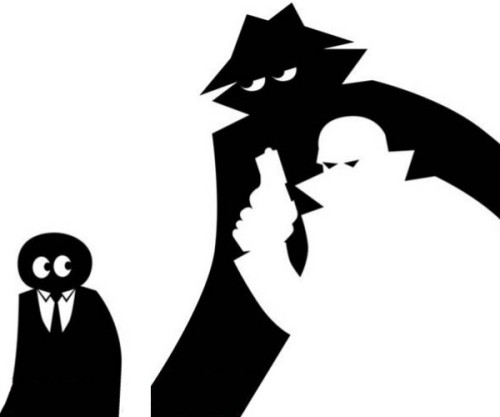 |
|
|
|
Part One: The
Mysterious Defection
|
Rick Archer's Note:
the
main source for
this section comes from the transcript from Burzynski
Documentary I
|
As the Nineties
began, it looked like Burzynski's work was gaining
wider acceptance.
In 1990, Dr.
Dvorit Samid, one of Burzynski's employees, brought serious
attention to the clinic's work with a well-received
presentation in Geneva.
In 1989, the
clinic retained Dr. Dvorit Samid as a consultant. Samid
did a lot of work with Antineoplaston’s ingredients.
In 1990 the
FDA tried once again to indict Burzynski, subpoenaing
thousands of documents and many of his employees.
Again the grand jury returned no indictment.
Meanwhile,
Samid managed to present her work at an oncology
symposium in Geneva, Switzerland. This
presentation landed her and Antineoplastons the cover
story in the 1990
July/August issue of Oncology News was devoted to Burzynski and his antineoplastons.
This in turn led to
what seemed like the breakthrough Burzynski was looking
for. Elan Pharmaceutical showed interest in
sponsoring some of the FDA trials of antineoplaston.
Due
to the enormous cost and time of the FDA Drug approval
process, about 10 years and $200 million (today it’s
about $400 million), Burzynski needed the help of a large
pharmaceutical company.
In return,
Elan would have unrestricted access to all of
Burzynski’s research and methodology. Burzynski opened
the door when he introduced Dr. Samid to Elan.
Samid had knowledge of antineoplastons based on the research
she had done for him in 1989-1990.
Burzynski
had patented some of the chemical identities of his
antineoplastons. However, he had not bothered patenting one of
them, identified as the chemical phenylacetate, because
when compared to the other antineoplastons, it was of little use
on its own in treating cancer
Mysteriously, three months
later Elan decided against signing a contract with
Burzynski. The stated reason was because the lack of
patent protection for phenylacetate.
Unbeknownst
to Burzynski, Dvorit Samid had become the recipient of a
grant from Elan to research phenylacetate.
Source:
Gavin Phillips
Dvorit's good
news was followed by more good news. The NCI asked to
visit Burzynski's clinic to review the clinic's work.
This official site visit took place in 1991.
Dr. Nicholas Patronas of NCI was
particularly impressed with the work. Patronas stated:
"So these
particular individuals not only survived, but they
didn't have major side effects. So I think it is
impressive and unbelievable."
Then in 1991 Dr
Michael Friedman, of Memorial Sloan-Kettering, stated
that antineoplastons deserved a closer look and recommended
clinical trials.
Since Friedman
was considered one of the leading authorities on brain
cancer in the world, his interest was important. It signaled that the key
players in the world of cancer research agreed Burzynski was on the right
track.
At this point,
drug companies began making inquiries about teaming up with
Burzynski. This was a huge step because this would
mean Burzynski would
finally have the money he needed to enter the final stages of
clinical drug
testing.
However, just
when pharmaceutical companies were beginning to show
interest in funding his work, they backed off due to FDA
hostility.
Fortunately, another
drug company, élan Pharmaceuticals,
decided to fund Burzynski anyway. The two parties quickly agreed to
financing, licensing, and royalty arrangements.
The outlook could not have been brighter. Money and
professional acceptance promised great things to follow.
Then out of nowhere Burzynski's career took a turn for the worse. The
problems began when élan Pharmaceuticals terminated their
licensing agreement, stating:
élan has
significant doubt as to whether the active substances
comprising of Antineoplastons have patent protection,
thereby rendering an agreement meaningless.
About this same
time, Burzynski discovered this same company had enticed
Dvorit Samid to come
work for élan.
Burzynski
shrugged it off. What was more important were the
upcoming NCI trials promised by Dr. Friedman.
In Burzynski's
own words:
Initially
everybody was very excited about the trials, everybody wanted to
proceed, the people who reviewed our results - the experts
from the NCI - they did a very good job.
They were
critical about some things, of course, but they were also highly
complimentary for the way we treated patients and the
results we got. It looked like everything should open up
and move forward.
Then suddenly
everything came to a stop.
And then
we found that a few months later Elan received
permission to do clinical trials with this particular
ingredient.
Meanwhile
our own trials were pushed back for four years.
This meant
élan
was allowed to proceed with their study ahead of
us. How could this be?
Burzynski sat in
stupefaction at this turn of events. First élan
Pharmaceuticals had lured Dvorit Samid away from him.
Now he witnessed the National Cancer Institute
recruit Dvorit Samid, his former researcher, to begin phenylacetate
tests without him.
Samid was being
allowed to run tests on the very materials she had learned
about while working for Burzynski, but his own clinical test
had been put on hold.
Furthermore, at
the same time as the FDA was giving permission Samid to
continue testing, the FDA was also busy taking Burzynski to
court.
While Burzynski
was facing continuous harassment from state and federal
agencies, the earliest phenylacetate studies were published
in April of 1992, authored by Dvorit Samid, hosted by the
National Cancer Institute.
Li-Chuan Chen
Something deeply
suspicious was taking place here. Unfortunately,
Burzynski was deliberately being kept in the dark.
Years after this incident took place, a man named Li-Chuan
Chen stepped forward to explain what was going on behind the
scenes.
Phenylacetate
was one minor ingredient in some of the antineoplastons that
Burzynski had not patented.
Burzynski had
failed to do so because his lawyers had counseled him that
the ingredient was so common and so well known that a patent
would never be granted.
As events would
show, they were wrong about that.
Elan
Pharmaceutical took this phenylacetate ingredient to the
National Cancer Institute (NCI) and proposed testing.
Now Dvorit Samid, the doctor who had defected from the
Burzynski clinic, was made NCI section chief.
Working at the
Johns Hopkins Cancer Center, Samid explored phenylacetate,
the chemical compound that was known to be an ingredient in
antineoplastons.
They quickly
received FDA approval for trials while Burzynski continued
to be stonewalled in his attempts to receive FDA approval
for trials.
The National
Cancer Institute pretended that they had
discovered this phenylacetate miracle all on their own.
Burzynski’s name failed to appear in the acknowledgments, or
any of the references listed in this report.
Oddly enough, Burzynski wasn't
worried. He expected these tests would fail since he
had already proven this in his own laboratory twelve years
earlier. But that didn't make it any easier to accept
that people were trying to steal his treatment formula
behind his back.
Abandoned by the
National Cancer Institute, he sat powerless on the sidelines
as the attempted high-jacking of his discovery unfolded
before his eyes.
Eventually the Hopkins
researchers realized Burzynski was right - phenylacetate
does not work on its own, a fact that was shown in their
trials.
The National
Cancer Institute, Elan, and Dr. Samid had spent over four years
and tens of millions of dollars testing phenylacetate, but
had little to show for their efforts.
Disappointed
after this failure, one would wonder if the FDA, the NCI,
and Elan Pharmaceutical decided they needed to find another way to get
the real thing.
|
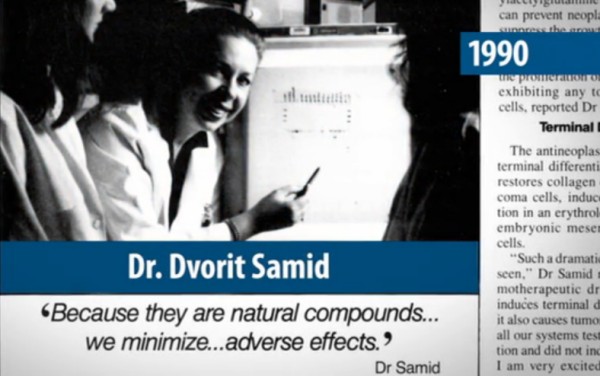
The mysterious defector
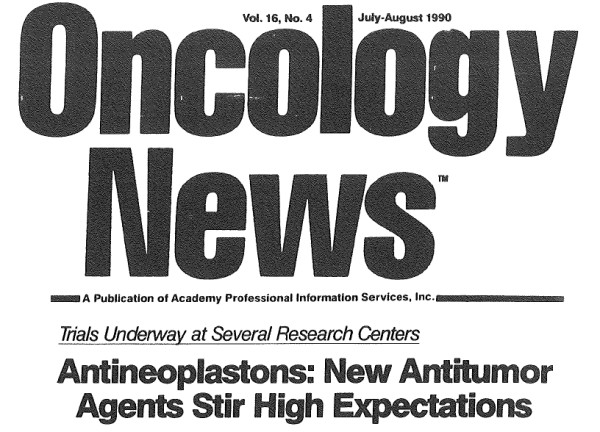

Impressive and unbelievable.
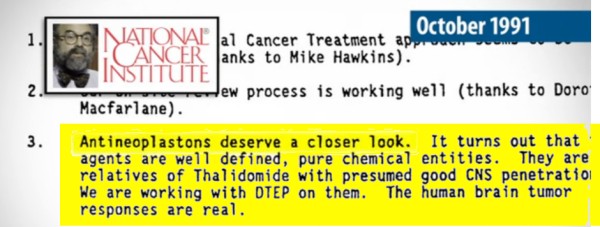
Antineoplastons deserve a closer look
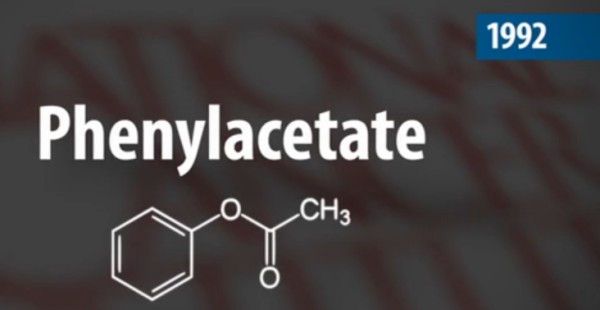
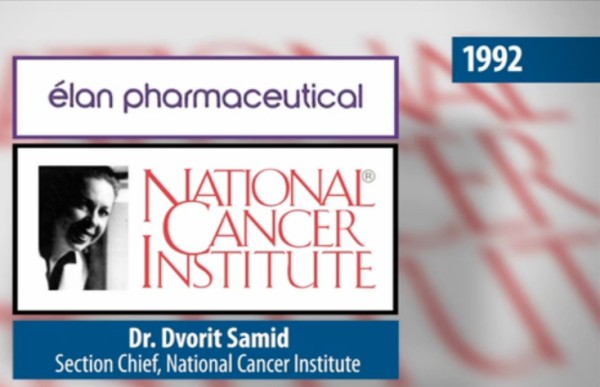
Dvorit Samid is
everywhere!
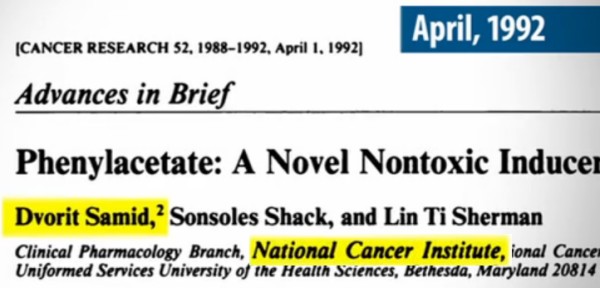
the earliest phenylacetate studies were published
in April 1992, authored by Dvorit Samid, hosted by the
National Cancer Institute
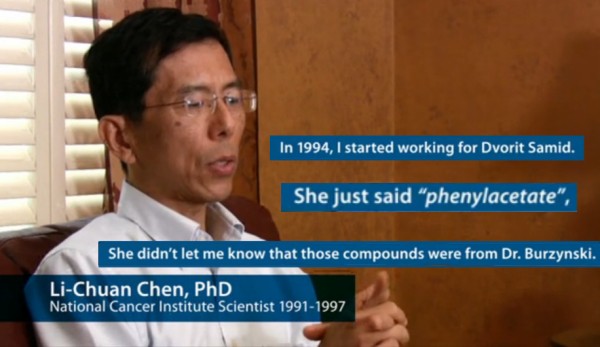
Dr. Chen's comments are taken from the Documentary Part One

 |
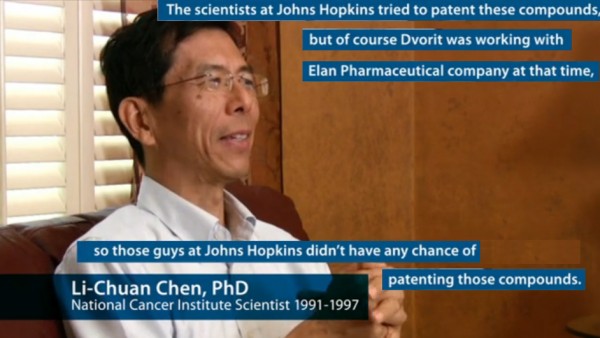 |
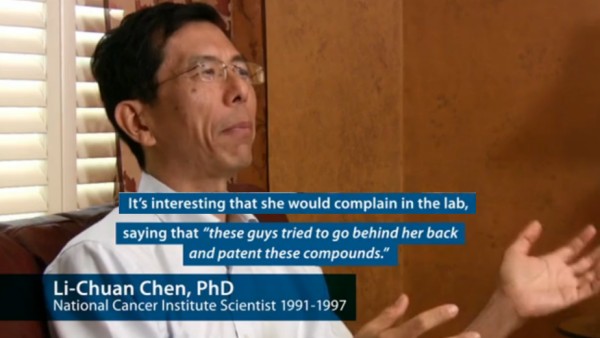 |
Part
Two: The Failed Tests at the NCI
|
Rick Archer's Note: I did the best I could, but
this was a very complicated story. The Burzynski Documentary did a much better job of
explaining this highly complicated issue of the failed NCI
test than I did.
Therefore let me
mention again the
film can be
viewed for free on the Internet. For this section,
scroll to 1:13:42 - 1:30:00.
Or, if you prefer, there is also an
Interactive sourced transcript of
the film that you can read to clear up any misconceptions.
One more thing - When I watched the Burzynski Documentary
the first time, I was a bit confused
about the big fuss over "protocols" because I was unfamiliar
with the term. So I looked it up. A clinical protocol describes a
method to be used in a clinical trial (e.g. of a drug
or medical treatment) or a medical research study.
You will now
read about a catfight between Burzynski and Michael
Friedman. Here is what I believe
this fight boiled
down to. This was a major test to see if Burzynski's antineoplastons
had any value. He was allowing Outsiders to use his
"secret cure" on patients with advanced disease, but Burzynski
would not be allowed to supervise. This was a lot more
serious than just letting a stranger drive your expensive
car... people's lives were at stake.
Therefore
Burzynski insisted on doing things his way for the SAFETY of
the patients and also to ensure his own treatment was given the
best possible chance of showing its value.
|
|
|
Now that the
National Cancer Institute’s Phenylacetate trials had failed,
associate director Michael Friedman came back to Burzynski
and offered to do trials with his antineoplastons.
So the question
should be raised: Why was the NCI receptive to Burzynski
again after deliberately pushing his work aside three years
earlier and promoting Dvorit Samid's research ahead?
Thanks to the
Samid debacle, Burzynski had his guard up.
Dr. Friedman
made some unusual demands. He said the test of
Burzynski's antineoplastons would only go forward if
Burzynski would agree to make major changes to the
protocols that he’d spent decades developing.
At first
Burzynski refused. Now Friedman threatened to find
other sources for antineoplastons.
Dr. Michael
Friedman told Burzynski,
"in response to your
correspondence, one last time, we will revise the protocol
with regard to dose and schedule in compliance, however, if
you are unable or unwilling to provide the Antineoplastons
in the near future, we will pursue alternative sources to
procure the drug, or its active components, and will
proceed."
Burzynski
responded.
"I appreciate very
much that you have finally decided to follow my
recommendation regarding dosage. But your final statements
that you are ready to proceed with the treatment with
Antineoplastons without our participation caught me by
surprise. It is hard to imagine that a federal employee
would consider patent infringement."
The NCI finally
agreed that Burzynski’s protocols would be followed. The
protocols were simple and routine for cancer trials.
Patients with very large tumors, multiple tumors, and
metastases were to be excluded. These protocols were
designed to rule out complicating factors that can skew
results.
Confident that
the NCI was finally on the right page, Burzynski released
his medicine to them to be tested on patients.
But then an
entire year passed with no patients being
enrolled. Something was wrong. Burzynski was
suspicious. Why were
they dragging their feet?
The NCI said it
was having trouble finding patients, which was absurd because there
were 16,000 people in America with the sort of advanced
cancer needed for the trial. Furthermore, any one of these people
would have jumped at the chance to test a possible
cure for their hopeless conditions.
The NCI used
their apparent inability to find eligible patients as a reason to justify
ALTERING THE
PROTOCOLS. They deliberately admitted
patients whose disease was far too advanced to benefit from Burzynski's treatment.
Burzynski heard
through the grapevine that the NCI had altered the
protocols to include cancers that were more complex than
had been agreed upon. He was furious.
This was wrong
for two reasons. First, for the test to succeed, it
was important that the treatment be given to patients
healthy enough to respond. Second, Burzynski would
have changed the instructions for dosages to treat such
advanced cancers if he had known what was going on.
In Burzynski's
own words, the dosages would have had to have been increased
at least three times. But since Burzynski was being kept in
the dark, there was nothing he could do for these patients.
Burzynski
complained to Friedman. He warned of likely failure. He insisted
the NCI follow his protocols as they had promised.
The NCI brushed
him off. "The
amendments have been approved."
They were going to do it THEIR WAY whether Burzynski liked
it or not.
As the conflict
escalated, the NCI quit sending data to Burzynski.
Burzynski had to resort legal means to get access to the
results of the trial using his own medications. He was
furious when he found out what was going on.
When Dr.
Burzynski finally got the data for the trial, he learned
that there were only nine patients enrolled, a ridiculously
low sample. Every one of them had
suffered from severe fluid retention, something that he
monitored and was able to prevent with his own patients.
Burzynski knew
from experience that fluid retention was a sign that the
antineoplaston level was too low. He suspected
that the antineoplastons were being diluted. The
concentration must be far too low.
Burzynski wrote
back that the patients were in danger, but no one listened
to him.
Then Burzynski
went on TV and said that he had gotten the distinct
impression that the NCI wanted the patients to die so the
trial would be over as soon as possible.
The NCI gave no
reply.
Burzynski asked
a question to the NCI: "There must be a reason why you
are afraid to provide us with complete copies of medical
records."
Burzynski
answered his own question. He stated that the NCI had used
different protocols and did not want to admit it.
Unfortunately, he had no proof since they would not send him
any records. Burzynski believed the NCI had
deliberately sabotaged his treatment in an attempt to
discredit him.
In Burzynski's own words:
(taken from a
2003 interview with
Gavin Phillips)
GP: When did
the NCI eventually start clinical trials of Antineoplastons?
SB: In 1994.
GP: I assume you gave the
doctors running the trials all the information about correct
dosages, is that true?
SB: Yes, well, basically they used dosages that
were 50 times lower than what we feel are effective dosages.
We have some patient’s relatives who were present when the
treatment was administered. Formulations of antineoplastons
were badly diluted. This means that the patient was
receiving very little antineoplastons and some of these
patients were removed from the treatment after a short
period of time because they were overloaded with fluid.
Well, normally
we see fluid overload in perhaps less than 2% of our
patients. So it makes sense that perhaps the formulations of
antineoplastons were diluted and when the Mayo Clinic (1999)
determined the concentration of antineoplastons in blood, we
realize that it was something like 50 times lower than what
it should be.
GP: Do you think the NCI
purposely sabotaged your trials?
SB: I have no doubt about it. They sabotaged
the trial; they accepted patients who were too advanced.
Their main effort was to give a low dose of the medicine for
a short period of time and to stop treatment just for some
minor problem, like if a patient developed a skin rash. They
were trying to give the treatment only for a very short
period of time, like for instance a couple of weeks or a
month.
GP: And then
of course the patient was dying after that. It was
completely unethical, it was horrible.
SB: As
you probably heard recently, a pharmacist who was diluting
an anti-cancer drug, was sentenced to 10 years in prison. I
think the same should happen to these guys who really were
trying to use this for their political manipulations.
|
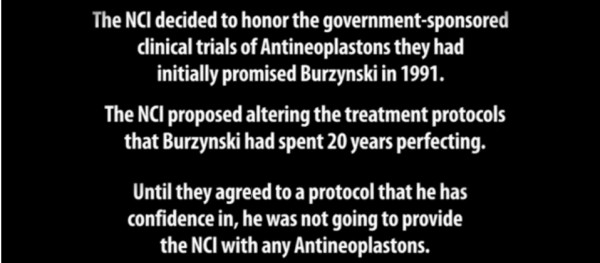
The NCI wanted to do
things their way, but Burzynski said no.
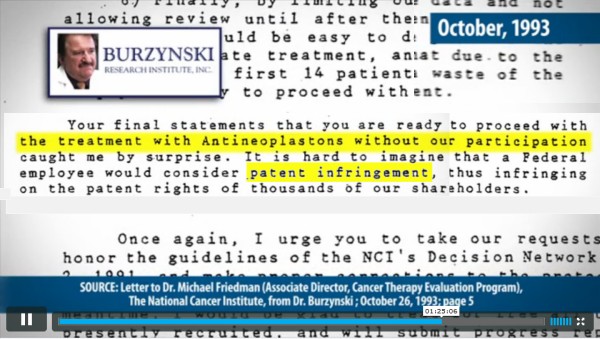
It is hard to imagine that a federal employee
would consider patent infringement."
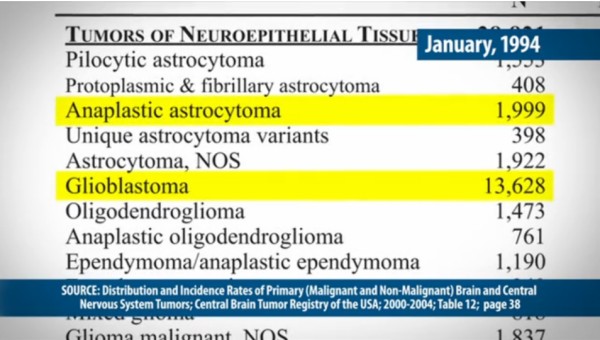
Plenty of candidates,
but the NCI could find only 9
people,
none of whom fit the protocols
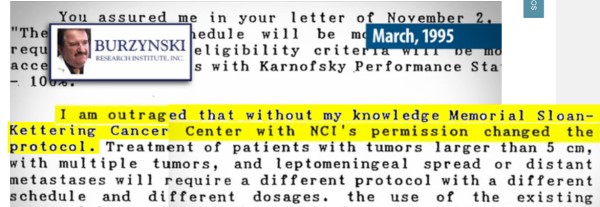
NCI had altered the
protocols
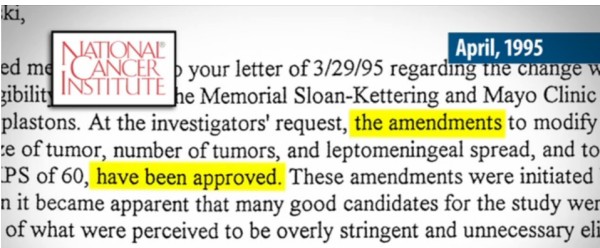
"The
amendments have been approved."
- the NCI disregarded Burzynski's objections
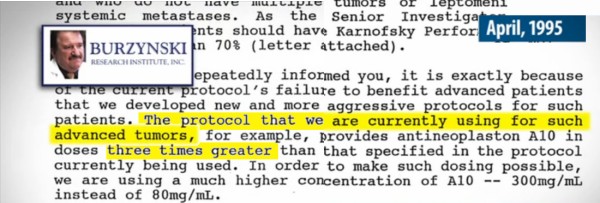
Burzynski suspected
that the antineoplastons were
being diluted. The concentration was far too low.

Burzynski warned that the patients were in danger,
but no one listened
to him.
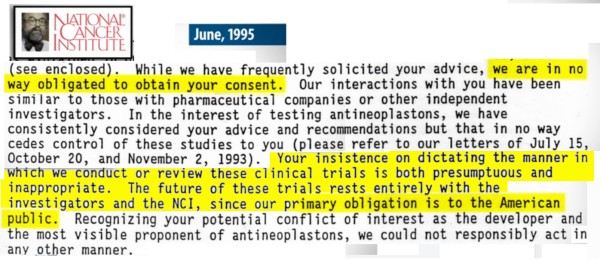
Burzynski
was reminded he would have no say-so
in how the NCI would conduct the trial
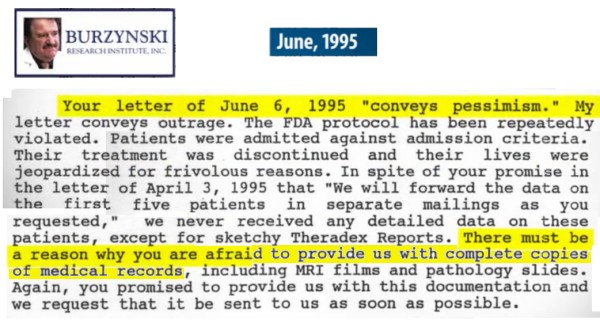
"There must be a reason why you
are afraid to provide us with complete copies of medical
records."
|
Epitaph: Four
Years Later
In a bizarre
turn of events, in 1999, four years after the failed drug
trials, Burzynski got the answer
he had suspected all along.
It happened when
the NCI published a report of its failed antineoplaston
trials back in 1995. The article stated
that
antineoplastons did not have cancer treatment potential.
One can assume
the researchers were doing the American medical community a
favor by showing proof that antineoplastons didn't work.
"No patient demonstrated tumor regression."
Of course what
they didn't mention that the failure to follow protocols had
likely doomed the experiment from the start.
However, someone
made a serious mistake. Whoever was responsible for
publishing this report was careless enough to also include
the Antineoplaston concentrations detected in the blood of
the nine dying patients during treatment.
The careless
person included the
actual figures from the trial. These figures showed
the actual antineoplastons in the blood of the patients were
3 times to 170 times less than the Burzynski clinic
typically measured for patients of their own.
Burzynski was
incensed... he believed the trial had been sabotaged!
Even more sinister was the fact that all nine patients died.
Although it is unlikely they would have survived even if they had
been given the proper dosage, they still were human beings
who deserved to be
given the proper treatment.
In
Burzynski's own words:
And that’s what
we found out from the patient’s husbands or the patients
themselves. That’s what they were doing. So this was
horrible. This was a criminal act. They should be
prosecuted for that.
Because
obviously, they knew what they were doing, and they knew
that these patients had really no chance to respond to any
treatment, they were going to die. And that’s what happened.
After we realized what they were doing, we decided to force
them to stop the clinical trials. And since then obviously,
The National Cancer Institute hates us, they do whatever
they can but they do not cooperate with us anymore.
|
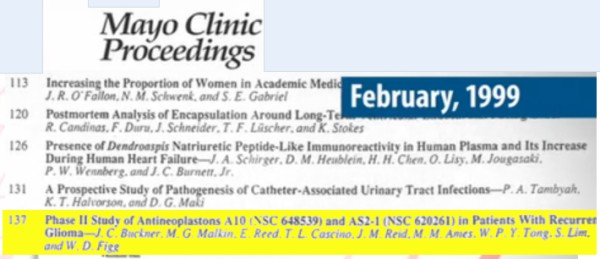
The NCI wanted to
publicize the failure of Burzynski's treatment
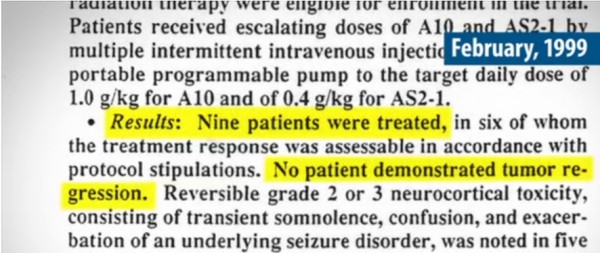
No
one got better...
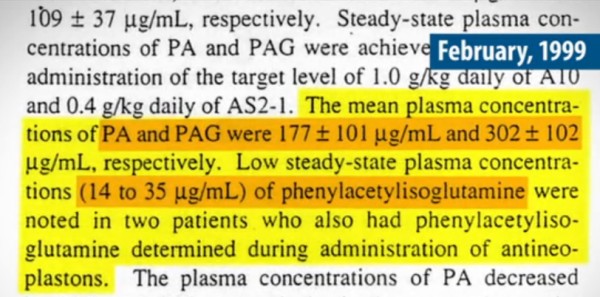 |
|
|
|
Part
Three: Patent Infringement
|
In science, when it comes to
patents, the credit goes to the man who convinces the world, not the man to whom the idea first occurs.
—
Francis Galton
|
On October 4th,
1991, the NIH conducted an on-site visit to the Burzynski
Clinic in Houston, Texas. You can see from the report
dated October 30th that the visit went well.
"It was
the opinion of the site visit team that anti-tumor
activity was documented...."
You may remember
that Dr. Patronas added his own thoughts:
"So these
particular individuals not only survived, but they
didn't have major side effects. So I think it is
impressive and unbelievable."
It was a
feel-good visit. Burzynski assumed that the headaches
of the Eighties were past and this was start of a new era.
Well, he was
right in one way. It was definitely the start of a new era.
Unfortunately, it was an era
of the most unbelievable harassment imaginable.
Seventeen days
later, on October 21st, 1991, The United States of America
as represented by "The Department of Health and Human
Services", and "Dr. Dvorit Samid" filed a patent for
Antineoplastons AS2-1.
They even had
the audacity to include Burzynski as a reference. Of
course Burzynski had no idea this was happening.
This was just
the start. Over the next year, with Samid acting as the front man,
the government
filed 11 different patents based on her work with
Phenylacetate, the one ingredient Burzynski had not
patented.
The patents
stated the rights to manufacture, use, and license it
belonged solely to the government.
Elan Pharmaceutical
had their name on the patents too.
Think about the
date. This meant had to be research going back several
years for them to be ready to make this move.
No one had told
Burzynski what was going on behind his back over at the NIH,
but for some time now Dvorit Samid had been working
feverishly in her laboratory trying to discover something
that could be patented.
One has to
wonder if the NIH on-site visitors know what was going on in
their own agency. Probably not or they would have
toned down their enthusiasm.
Dvorit Samid
stayed busy. Over the next four years, she cranked out a
total of 11 patents.
NARRATOR:
Five months
later, the United States of America and Dr. Dvorit Samid
file their second extended patent on Antineoplastons.
And, guess who else was in it?
Elan Pharmaceutical Corporation.
One can only
wonder what Burzynski's horoscope looked like for 1995, but
it could not have been good. In June, 1995, the United
States government filed its 11th and final patent.
Then a couple of
months after the eleventh patent was filed, Dr. Michael
Friedman, the same man who had obstructed Burzynski’s trials
at the National Cancer Institute, left his position at the
National Cancer Institute. Friedman became Deputy
Commissioner of Operations for the FDA. He was now working
directly under Dr. David Kessler, the FDA commissioner who
had
declared war on Burzynski.
One could make a
case the forces of the dark were lining up against
Burzynski. This move by Friedman gave the appearance
that the NCI, the FDA, the U.S. patent office, Dvorit Samid
and Elan Pharmaceuticals were all connected. Sure enough, trouble was right around the
corner.
In November of 1995, after a decade of failed
grand juries, the United States of America’s Food and Drug
Administration finally managed to indict Dr. Burzynski. Burzynski
was going on trial.
This breathtaking chain of events took Burzynski aback.
All the foot
dragging, all the blown protocols, all the excuses, all the
back and forth letters and all the strange omens began to
make sense when he finally learned the patents were being
filed. The NIH had been stringing him along to buy
time.
In his opinion,
all this harassment was meant to disguise the fact that
powerful government officials and the pharmaceutical
industry had been conspiring to steal his invention all
along.
By the year
2000, all eleven patents had been approved. Burzynkski
says he isn't worried about them, but these 11 copycat
patents are still in play today.
STANISLAW
BURZYNSKI -
on camera interview:
And as we know, all of this was
being done based on the fact that the United States, which
is the National Institute of Health, together with a
pharmaceutical company, which is Elan Pharmaceuticals, was
trying simply to steal my invention.
That’s what they
wanted. It’s not that we had a successful visit from the
National Cancer Institute in which they determined that
“this treatment works great” and they decided that we should
go into Phase 2 clinical trials which would be sponsored by
them. No.
This gave the
idea of some high-ups at the FDA to conspire with the
pharmaceutical company so that they could steal the
invention from me and get it, because it was good.
That’s the whole story.
They knew that if I’d be still free, they won’t be able to
do it. Because they knew that if I would sue them they
wouldn’t have a chance in court because we have our patents
before them.
So that’s why
they attempted to wipe me out financially, to put me in
prison, to attack me from every possible angle: FDA, which
is the federal government, state government... to be able to
steal my invention. That’s the real thing from the National
Cancer Institute and Elan Pharmaceuticals.
They failed.
We survived, and we continue to move forward.
DR. JULIAN
WHITAKER -
on camera interview:
Now how could
the U.S. Patent Office be corrupted to the point that they
issue patents on medical therapies that have already been
patented, and issue them to someone who had nothing to do
with their discovery or use? How could that happen?
And how could
the patent office then assign these fraudulent patents to
some of the most powerful institutions in American
government? And imagine, all of this was being done
while these same government agencies were spending millions
of taxpayers dollars trying to put Dr. Burzynski in jail so
he could not fight the criminal theft of his discovery.
Well, what about
the ten million patients who have died of cancer over the
last twenty years?
The majority of them could have been saved if the government
had not blocked the therapy that they knew could save them.
True progress in medicine has always, without exception,
been violently resisted by medical authorities who cling to
the beliefs of their time.
Now today we
have the same kind of arrogant commitment to belief, but
with cancer treatment we have a trillion-dollar business
built on top of those beliefs.
The problem that
we face however, is that a huge financial house has been
built on the paradigm of purging the body of cancer cells.
Burzynski’s
discovery means that the foundation, the walls, and the roof
of that house, need to be replaced. Think about it, we’ve
got thousands of doctors in oncology, and in oncology
residency programs, we’ve got the pharmaceutical industry
pumping out chemotherapeutic agents every month. There are
all kinds of machines that deliver radiation, we’ve got all
this stuff in the war on cancer, and it’s trillions of
dollars
|
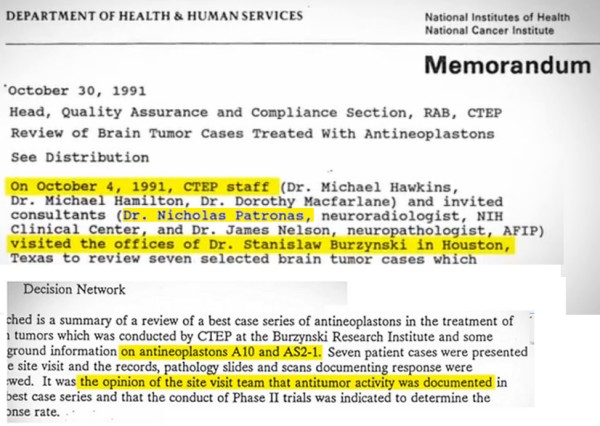
"It was
the opinion of the site visit team that anti-tumor
activity was documented...."
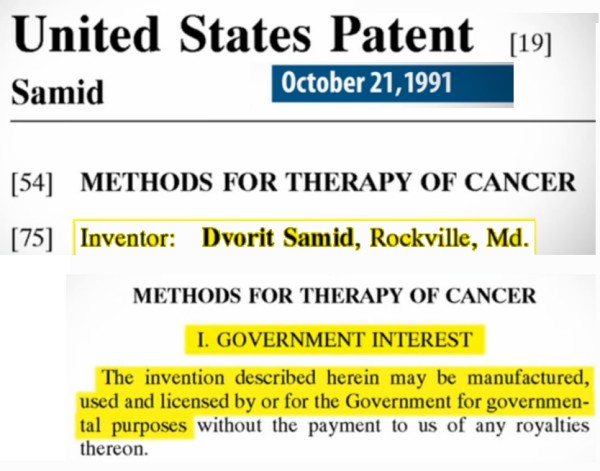
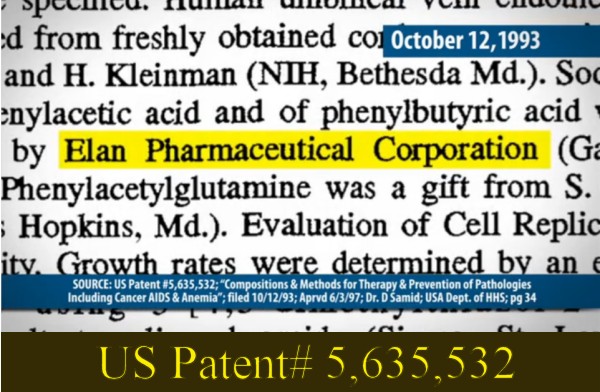
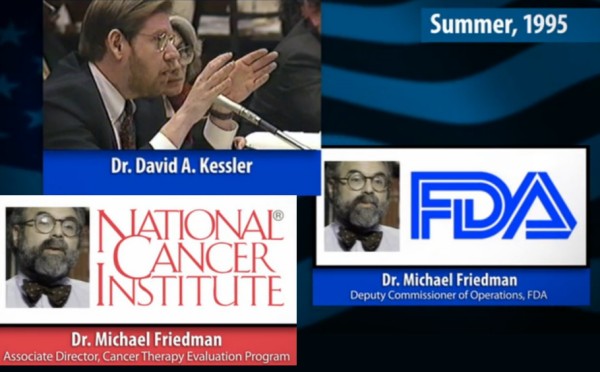
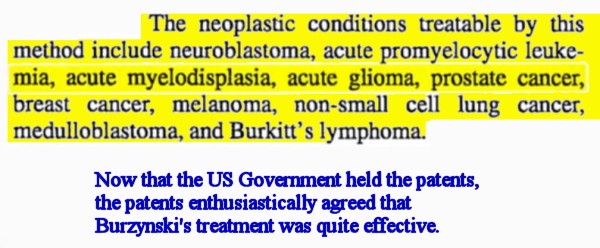
Source One
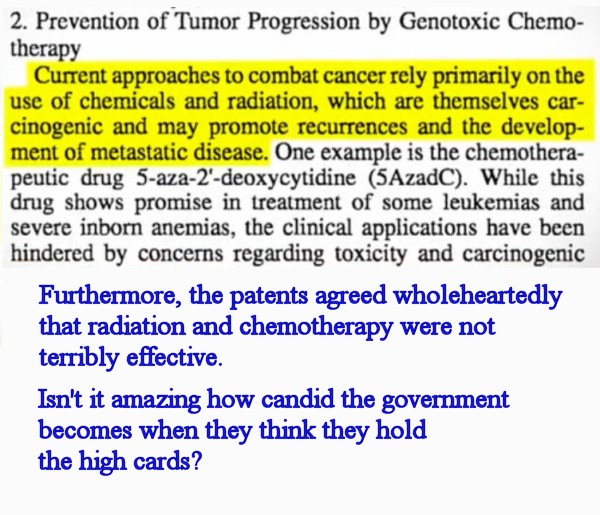
Source
Two (
(hint use the "Find"
function and type in 'Genotoxic')
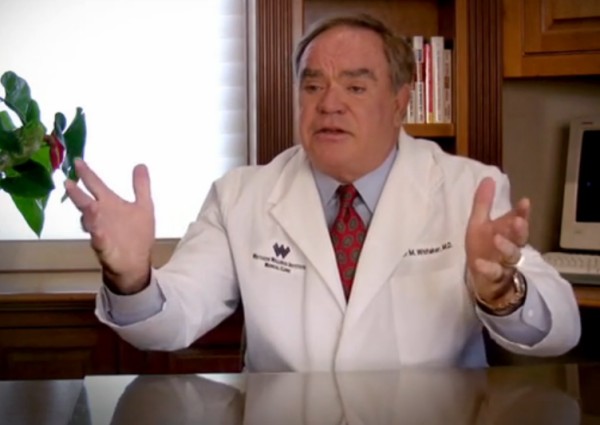 |
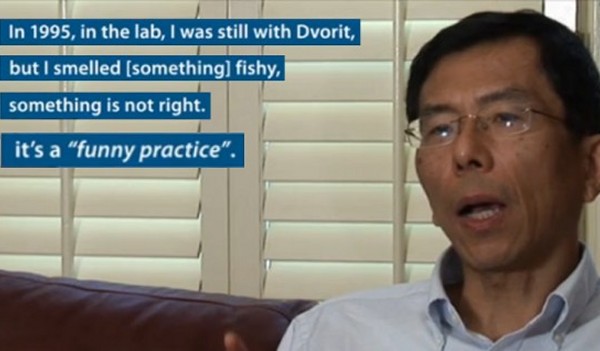 |
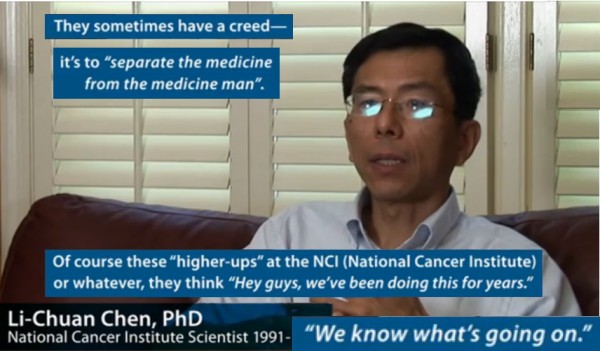 |
Dr. Li-Chaun Chen
Rick Archer's
Note: To me, the appearance of this researcher,
Li-Chaun Chen, is without a doubt the most provocative
feature of the entire documentary. And that wasn't
easy - the whole damn documentary made me mad.
But to have this
quiet, unassuming man sit before the camera and say the things he said
was unbelievable. It was the most incredibly brave
thing I have seen since Jeff Wigand sat before the 60
Minutes cameras and exposed the tobacco industry in 1996.
Naturally I was
curious about this man. So I linked his name with Gorski
and Blaskiewicz, Burzynski's two major critics. I
Googled their names together and came up with nothing. Nada. Nil.
I went through 10 pages of Googles and didn't see one post
where Gorski and Blaskiewicz attacked Dr. Chen's
credibility.
That's amazing. Why? These men criticize and attack everything
about Burzynski!
But they won't touch Li-Chaun Chen.
Very curious.
There can be no
doubt the man exists. And there can be no doubt Dr.
Chen knew Dvorit Samid personally. See the picture on the
right if you don't believe me.
To me, the boost
this humble man gives to Burzynski's credibility on the
issue of the patent theft and the deliberately sabotaged
clinical trial is astounding.
Considering how easy it is to sue people,
for this man to name names and say what he said is
unbelievable. But I saw no obvious challenge to his
veracity.
Li-Chaun Chen is one of my heroes.
Very brave man.
|
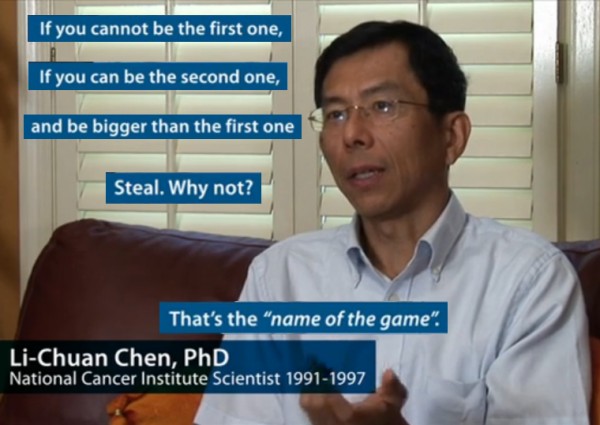
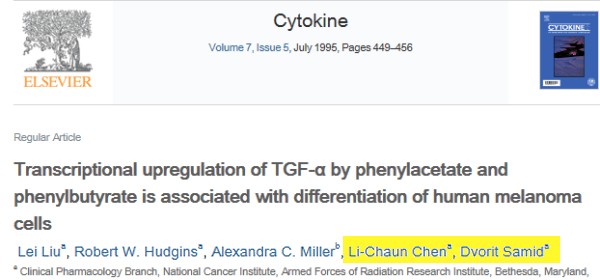 |
|
|
Part
Four: The Legal Trials of Doctor Burzynski
|
Rick Archer's Note: For the following
description of Burzynki's legal problems, I relied primarily on
the Documentary's Interactive Web Site concerning the
doctor's legal problems. Source:
Burzynski Transcript Chapter
Six.
|
Stanislaw
Burzynski has been involved in a continuous Legal Fight that has
lasted for the past two decades.
The Justice Department, the FDA and the Texas Medical
Board of Examiners have been waging a campaign to stop
Dr. Burzynski from treating patients with
antineoplastons
Federal law, which covers drugs in interstate commerce,
is clear enough - doctors can only prescribe drugs
approved by the FDA although with its approval they can
give patients experimental drugs as part of clinical
trials to test safety and efficacy.
In
his own words...
Dr. STANISLAW BURZYNSKI -
on camera interview:
In 1977
before I started, I asked my lawyers for their
advice:
"Can I use an experimental treatment—which
was the treatment of Antineoplastons—can I use this
in my private practice, and can I be involved in
cancer research, as simple as any private company?"
They
said yes, I could."
|
 |
|
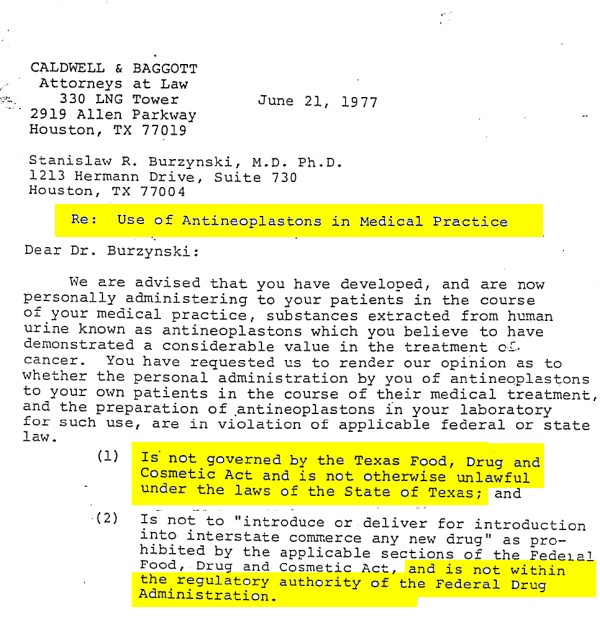 |
NARRATOR
(reading along with highlighted portions of this
legal opinion letter from his
attorneys dated June 21, 1977):
Dr.
Burzynski’s attorneys investigated both state and
federal law to find out if it was legal for him to
start his own biomedical research company, making
Antineoplastons, and administering them to his
patients within his private practice.
They
found that according to both the Taxes state and
federal law, the use of any drug, or new drug, can
be used to meet the immediate needs of the patients
of a licensed doctor—particularly when there was no
other available option for them.
The law
stated that such activity was not governed at the
time by the Texas Food, Drug and Cosmetic Act and is
not otherwise unlawful in the state of Texas.
However,
Dr. Burzynski would not be legally allowed to
introduce or deliver Antineoplastons into interstate
commerce. Which means, he had to keep his activity
only within the state of Texas to avoid breaking any
federal laws.
As long
as he did this, his actions were not within the
regulatory authority of the FDA.
|
Law or no law, the
FDA began its warnings to Dr. Burzynski in 1978. The
FDA informed
him that he was violating Federal law by providing
antineoplastons to patients outside of clinical trials.
The formal
problems started in 1983. The FDA obtained a permanent
injunction from a federal district court prohibiting Dr.
Burzynski and the Burzynski Research Institute from shipping
antineoplastons in interstate commerce without first
obtaining the approval of the FDA.
The injunction,
however, did not preclude intrastate distribution of the
antineoplastons. As long as Burzynski stayed inside
state lines, he was free to go about his business.
|
Texas Board of Medical
Examiners
|
1984
Burzynski said
his first trouble with the Texas Board of Medical
Examiners took place around 1984. Some of his
patients told him that they were being approached by the agents
sent to them by TMB agents. These agents were trying to convince them
to file complaints against their doctor. However, the agents
couldn't get anyone to cooperate, so they went away.
Shortly after
that, Burzynski met a man who informed him he would soon
have serious problems with the Texas Board of Medical
Examiners. And obviously the man was right.
In his own
words...
Dr. STANISLAW BURZYNSKI -
on camera interview:
But nothing
else happened at the time in 1984 until I met, by coincidence,
the Vice President of M.D. Anderson Cancer Center, Dr.
Hickey, who informed me that I will have problems with
the Texas Board of Medical Examiners.
And
obviously the problems began. I was called to the Texas
Board of Medical Examiners, they began investigating me.
However, there were no complaints from the patients, the
patients were happy, we were treating patients who were
very advanced, for whom there was no treatment
available, and they were getting good results. So,
apparently, there was no justification for such action.
This was a very unpleasant investigation, they were
trying to convince me again to stop my research and to
stop treating patients. After about two year of going
back-and-forth and being called to the board—finally,
they proposed to me that I should present to them a
number of cases of patients who benefited from my
practice.
1986
Two years later,
it started up again. On July 28, 1986, the TMB began
investigating Dr. Burzynski, even though no formal complaint
had been filed.
Burzynski was
able to get the TMB off his back by agreeing to send a list
of 40 successful cases. On November 18, 1986, a
notarized agreement between Burzynski and the TMB was
created. Burzynski submitted double that number.
He never heard back.
1988
However, two years later, the board came back again.
It not only pretended that the cases he submitted were not
successful, the TMB claimed the doctor was violating a law
that didn’t exist and which, by the way, was grounds for the
board to cancel, revoke, or suspend his license.
On September 6,
1988, the TMB convened a hearing to decide whether or not to
revoke Burzynski's medical license.
Burzynski had
cooperated with the TMB in 1986. But now he was
beginning to lose his patience. He did not appreciate
what he felt was a witch hunt. In his own words:
It was a
shock to me. I believed in justice, I believed in the
high ethics of the board, but this was just a lie.
1990
and 1992
NARRATOR:
In
1988, it was abundantly clear that the medical board had no
case against Burzynski. Which prompted the board to file
their first amended complaint in 1990.
However, the
still the board had no case, so they decided to file a
second amended complaint in 1992.
It was time for
another Texas-style version of Kangaroo Court. The
medical board kept coming back each time with the same
argument, practically making Xerox copies of their prior
claims, changing the titles and simply resubmitting them.
So far
everything had been a series of skirmishes. Things
began to heat up in 1993. This time the Medical Board
decided to get serious.
1993
In 1993, sixty
of Dr. Burzynski’s patients petitioned the board to stop
harassing their doctor.
The board then
tried to ignore these petitions by attempting to strike them
from the record.
Finally in May
of 1993, this case went to trial. There were several
very bitter confrontations between Burzynski and the
prosecutor. Burzynski clearly lost his temper.
SB: "They will die! There's nothing in the world but my
treatment that can save these people's lives!"
State
Prosecutor: "You intend to continue just what you
have been doing until someone is able to stop you, is
that not true?"
SB: "I am going to do what the law will allow me to do. And
I'm going to do whatever is necessary to bring my
medicine to approval in the United States. And I am
going bring you to justice for causing the death of 200
patients! I'll come back here to haunt you until
you are dead!"
State
Prosecutor: "Are you threatening me, Dr. Burzynski?"
SB: "I'm not threatening you, but that's what's going to
happen in the future."
State
Prosecutor: "That remains to be seen."
Apparently the
State of Texas didn't do a very good job of presenting its
case. In the words of Judge Earl Corbitt, he was never
quite clear what the TMB's problem was.
Corbitt said the State of
Texas didn't put one expert witness on the stand.
Without someone to give an opinion, Judge Corbitt said he
wasn't able to give credence to TMB's position.
On the other
hand, Corbitt pointed out Dr. Burzynski's lawyer had Dr.
Patronas, a
highly credible witness from the NCI, in court to testify.
NARRATOR:
During this 1993 trial, one of the National Cancer
Institute’s leading experts, Dr. Nicholas Patronas,
decided to testify.
Patronas, a
board-certified radiologist since 1973, professor of
radiology at Georgetown University, and founder of the
neuroradiology section of the National Cancer Institute,
recognized the absurdity of the Texas Medical Board’s
case against Burzynski.
So he put
his own career on the line and flew himself to Texas to
testify on Dr. Burzynski’s behalf.
Dr. Patronas
testified under oath his role at the National Cancer
Institute.
|
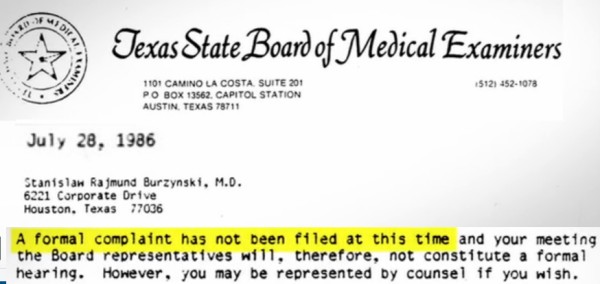

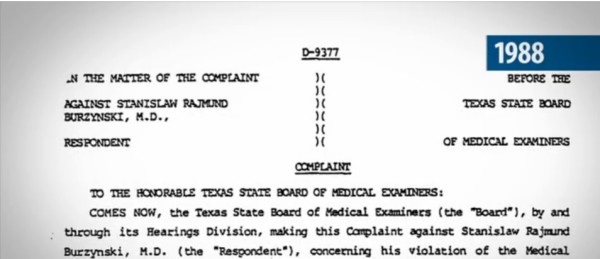


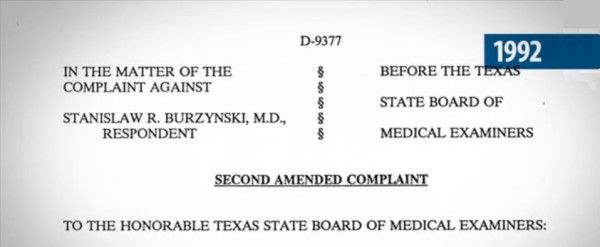
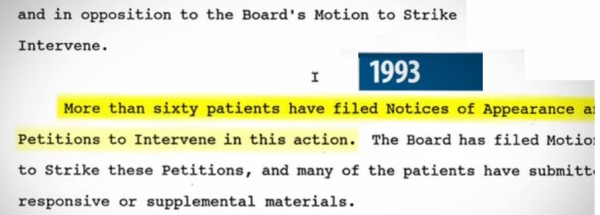

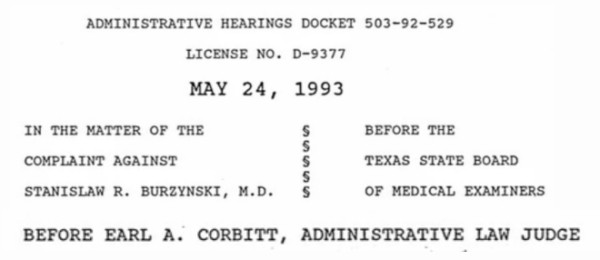
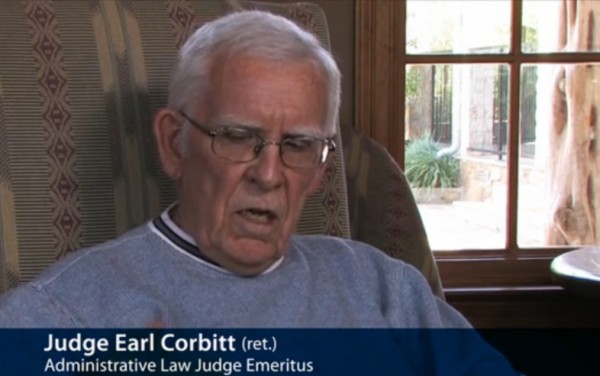
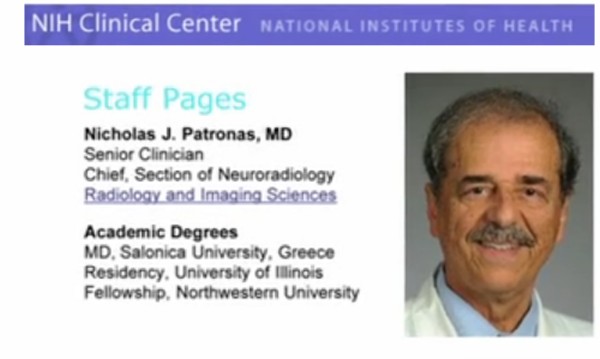 |
|
(Rick
Archer's Note: You really should watch this
trial for yourself. The drama was amazing.
Start at
40 minutes.
) |
Richard Jaffe, Attorney for Burzynski,
questioning Dr. Nicholas Patronas, NIH, at the 1993 Trial
Q (Jaffe): Basically, just in
layman’s terms, you do all of the imaging work and
interpretation for the National Cancer Institute’s testing
of drugs?
A (Dr. Patronas): Exactly. That’s my job, to assess the
effectiveness of the drugs that are given there.
Q (Jaffe): Did there come a
time when you became aware of Dr. Burzynski?
A (Dr. Patronas): Yes, the National Cancer Institute asked
me to join a group of other physicians and scientists, and
come to Houston on a site visit to Dr. Burzynski’s
Institute. I was called as an expert in assessing the images
to evaluate the effectiveness of his treatment. The basic
conclusion, was that in five of the patients with brain
tumors, that were fairly large, the tumor resolved,
disappeared.
Q (Jaffe): And that’s part of what you do at the hospital,
is to evaluate treatments on brain cancer patients?
A: Well, since I am the
neuroradiologist I see all brain tumors. And I see a large
volume of them.
Q (Jaffe): You testified that
five of the patients had their tumors resolved, they all...
A (Dr. Patronas): Disappeared.
Q (Jaffe): Disappeared? Can you
give us some kind of context of that? How often does that
happen? Just by spontaneous remission?
A (Dr. Patronas): I’m not aware that spontaneous remission
occurs. The available treatments rarely produce results like
that. The only medication, the only treatment, which I think
is a last resort, is radiation therapy. Conventional
chemotherapy is—provides very little, nothing, basically. So
when this happens it is very rare. In these cases, all of
the patients had already failed radiation.
Q (Jaffe): What happens with these
patients, who failed radiation, with brain cancer?
A (Dr. Patronas): That’s it. They die.
Q (Jaffe): You are saying, that
if someone has already failed radiation, there’s not much
else?
A (Dr. Patronas): Nothing to offer, exactly.
Q (Jaffe): And there is nothing
that you can do at the National Cancer Institute?
A (Dr. Patronas): Nothing we can do, not at this present
time.
Q (Jaffe): What about these five
patients? How come they lived?
A (Dr. Patronas): Well, it’s amazing, the fact that they are
not handicapped from the side effects of any treatment, and
the side effects of most aggressive treatments are worse
than the tumor itself, so these particular individuals not
only survived, but they didn’t have major side effects. So I
think it’s impressive and unbelievable.
|
Q (Jaffe): How many times have you
seen this in your experience? How often does this happen?
A (Dr. Patronas): I don’t. I have not seen it at any time.
Q (Jaffe): Now, let me ask you
your opinion or advice. Based on what you have seen, what
would happen, let’s say, for some reason Dr Burzynski’s
brain tumor patients can’t get his medicine anymore, and
have to go off treatment. What’s going to happen to them?
MR. HELMCAMP (prosecutor):
Objection, Your Honor, not relevant.
MR. JAFFE (defense): I think it
is relevant. That’s really the issue we are advocating in
this case.
JUDGE: Overruled.
A (Dr. Patronas): I think these patients will die.
|
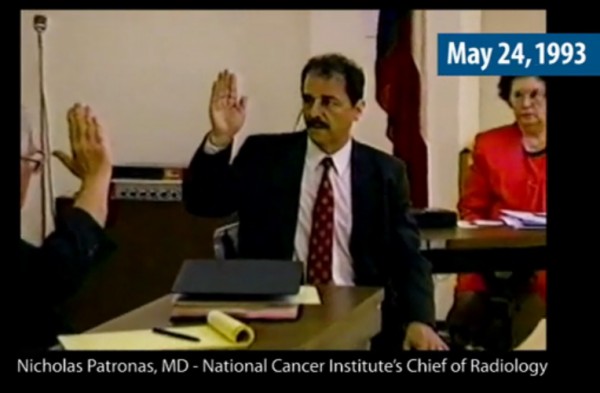 |
Judge Corbitt
said that Dr. Patronas was quite a witness.
Corbitt said
Patronas was impressive. Corbitt specifically remembered when Patronas
said he had never seen what Burzynski was able to accomplish
using his antineoplastons.
Dr. Patronas:
"The tumor disappeared!
It's amazing, it's impressive, it's unbelievable!"
Corbitt added:
"Another
thing that helped Burzynski was that boy. He had one young boy there, about 12. Strapping lad, good
sized boy, his name was Paul. When Paul was 4, his doctors
gave up on him. His mother was furious with the State
of Texas for bringing this law suit. She said she was scared
to death this treatment was going to be taken away. Heck,
for all I know, that boy might still be alive!"
After the
withering testimony of Mary Michaels, Paul's mother, the
state prosecutor completely caved in.
"Oh,
never mind. No more questions."
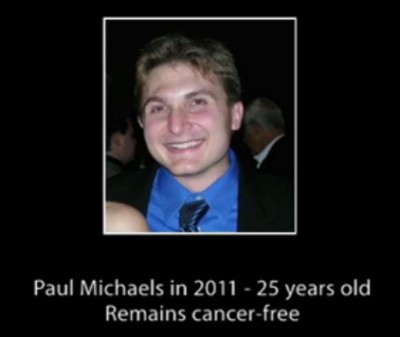
|
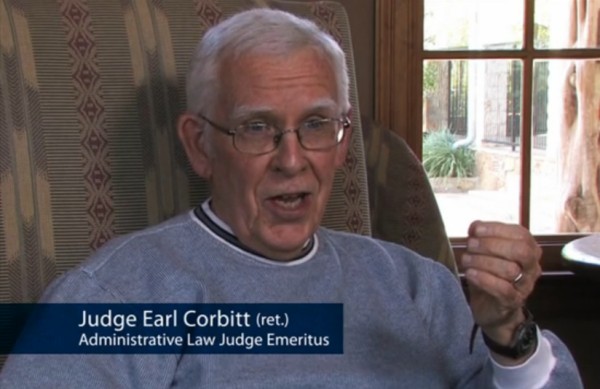
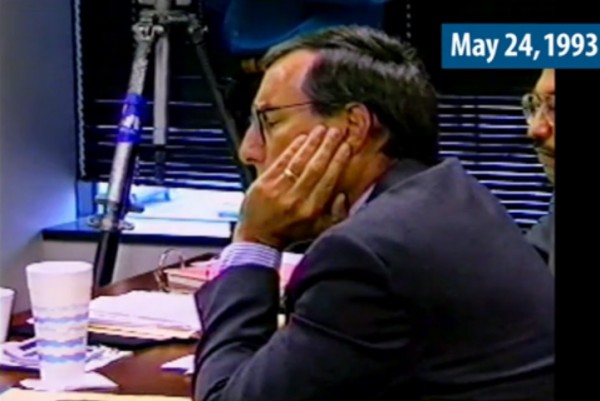 |
Not
surprisingly, Judge Corbitt ruled in Burzynski's favor.
In his decision, Corbitt said the following:
-
The State of
Texas did not prove that antineoplastons are dangerous.
-
The State of
Texas did not produce competent testimony to show why
the drug was no good.
-
The laws of the
State of Texas do not prevent Burzynski from doing what
he is doing.
How much clearer
can that be?
One would assume
the State of Texas would put down its cards, fold up its
tent, and slink away. Not Texas.
Judge Corbitt
stated on camera:
"After the
trial, they told me they were going to rewrite my
proposal or my decision and take adverse action against
Dr. Burzynski. I replied I thought that was kind
of foolish."
1995
Sure enough, the
Texas State Board of Medical Examiners came after Burzynski
again in 1995.
TV News footage
of the 1995 trial stated this:
The state of
Texas wants Houston doctor Stanislaw Burzynski to stop
treating his patients with drugs that he produces at his
own pharmaceutical plant.
The drugs called Antineoplastons are non-toxic compounds
of proteins and amino acids, often lacking in cancer
patients.
Even
though the state of Texas acknowledges that the drugs
may be helping some who are terminally ill, the state
says the drugs shouldn’t be used.
This is the
state board of medical examiners, which licenses doctors
in Texas, this is the agency challenging Dr. Burzynski
in court. One judge (Corbitt) has already told the board
members that they don’t have a case.
The Texas State
Board of Medical Examiners lost the 1995 round as well, but
that didn't stop them.
1996
They took the case to the Texas
Supreme Court. This time Burzynski was placed on
probation... but he was still allowed to keep working.
Not only did
Burzynski successfully serve his probation, but again the
Texas Medical Board was completely unsuccessful in their
efforts to remove his medical license.
So if the safety
of the drug was not an issue, and if Dr. Burzynski wasn’t
breaking any laws, then why would the Texas Medical Board
continue on with this empty pursuit?
People were
starting to get suspicious that the FDA had been pressuring
the Texas Medical Board to continue trying to take away Dr.
Burzynski’s medical license.
ABC News
clip:
For this
story we wanted to talk to the FDA about its policies
and procedures. The FDA did agree to talk to us on
background where it wouldn't be quoted, but they
repeatedly refused our requests for on-camera
interviews.
With all options
to stop Burzynski exhausted at the state level, at this
point the FDA decided to step in. The
Documentary suggested the following motive:
NARRATOR:
The FDA and PhRMA realized
that if Burzynski’s discovery was given a fair review
process, not only would chemotherapy and radiation
dwindle into obscurity, financially crippling the
industry, but it would also mean that for the first time
in history, all of that income would funnel away from
PhRMA and into the lap of one single scientist, who
holds the exclusive patent rights.
The fiercest
fight in FDA history was about to begin.
|

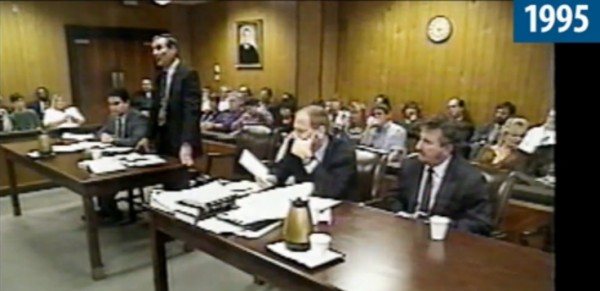
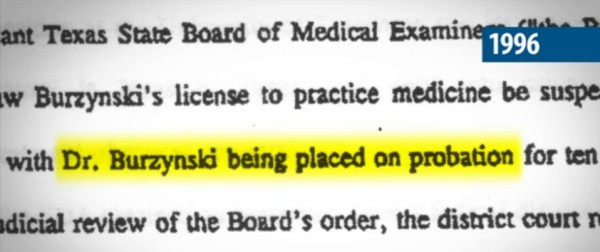
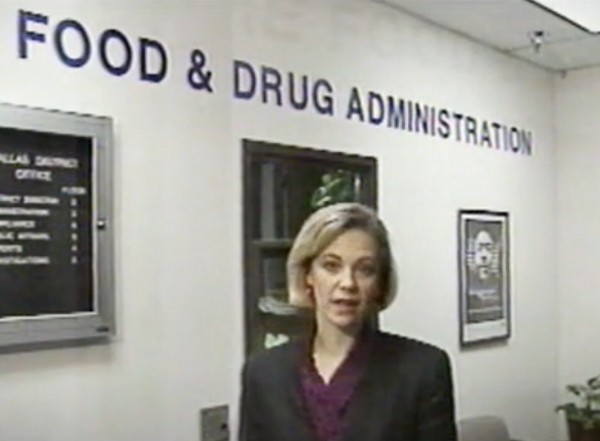
This ABC
correspondent is saying the FDA refuses to answer
her questions on camera. |
| |
|
The
FDA versus
Doctor Burzynski
|
Rick Archer's Note:
The
main source
for
this section comes from the Chapter Seven transcript from
the Burzysnki
Documentary I ]
|
The Documentary
states that at the same time the Texas State Board of
Medical Examiners had been pursuing Burzynski, the FDA had
been pursuing parallel measures again Burzynski as well.
1983
In 1983, the
American Cancer Society placed Dr. Burzynski's therapy on
its "unproven methods" list.
That same year,
the FDA sought an injunction to stop Dr. Burzynski from
treating cancer patients because the FDA had not approved
the drug.
At that point
the FDA commenced a civil action to try to close the clinic
and stop all patients from receiving the medicine.
NARRATOR:
In 1983,
before the judge in this case had announced her ruling,
the FDA sent her a letter.
The letter warned her in advance
that if she declined to grant the injunction sought be
the government - thus permitting the continued manufacture
and distribution of antineoplastons - then the government
would then be obliged to pursue other less efficient
remedies.
"actions for seizure"
- code for
raiding his clinic and home.
"condemnation of the
drugs" - code for a propaganda campaign.
"criminal prosecution of individual"
- code for doing everything in its power to
throw Burzynski in prison.
[SOURCE: 1983 FDA letter to Judge pg 2]
.......
Federal Judge
Gabrielle McDonald denied the FDA's request. Instead, she
ruled that Dr. Burzynski could continue to treat patients in
Texas, but she prohibited him from shipping the unapproved
drug across state lines.
As the letter
ominously predicted, the FDA indeed had "other ways" to stop
Burzynski.
Dr. Burzynski would face numerous
battles with the federal government over the
next 14 years.
Between 1986 and 1994, he was subjected to
constant harassment. During that
time federal officials raided his research clinic and
confiscated his patients' medical records.
On July 17,
1985, there was an enormous raid by the FDA of
Burzynski’s office. They seized over 200,000 medical
documents including hundreds of confidential patient
files.
They
literally went through every scrap of paper in his
office. For Burzynski to gain access to his own patient
files he had to install his own copying machine in the
FDA’s offices and give them a day or two’s notice for
them to find the file in question.
A laborious
and time consuming process when peoples lives are on the
line. On some occasions they “lost” or misplaced a
patients files. One patient, William Cody, demanded his
medical records back, which contained vital information
to his recovery. Cody says the FDA’s Compliance Officer
Kenneth Ewing told him “those records were no longer my
property…” (“The Cancer Industry" p288)
Cody went to
Ewing’s superior in Dallas and was told he could have
his records if he applied to the FDA in Houston. When he
did so Ewing told him they could not be found. But
later, when Burzynski’s lawyer called Cody as a witness
before a federal judge, his records suddenly resurfaced.
Source:
Gavin Phillips
During those years, three
federal grand jury investigations were
convened without a single indictment ever handed
down.
1995
In March 1995,
Dr. Burzynski appeared on the CBS TV show "This Morning,"
accompanied by three of his patients.
That very same
afternoon, the FDA raided his clinic again. The timing
hinted at retaliation for the TV interview.
Shortly after
the raid, a fourth federal grand jury investigation got
underway.
Rick
Archer's Note: One of the dirtiest tricks the
FDA played was to ask the judge to discontinue treatment
to the children. This happened on several
occasions.
When one listens to the heart-rendering cries of the
parents who are being threatened with the loss of the
only thing keeping their children alive, it is very
difficult not to feel intense anger at the insensitive
bureaucrats.
Representative Joe Barton
With the threat
of seeing their doctor potentially being thrown in jail and
the possibility of his life-saving treatment discontinued,
several of Burzynski's patients asked Joe Barton, their
Texas representative in Congress, to intervene.
In 1995, Rep. Joe Barton (R-TX) questioned whether the FDA
had used its power to retaliate against Dr. Burzynski.
"It is
extraordinarily rare for a grand jury to fail to indict at
the request of a U.S. Attorney," Barton told The
Washington Times. Barton noted that a grand jury's
failure to indict someone after three attempts is "virtually
unprecedented."
On July 25,
1995, Barton convened a Congressional Subcommittee hearing.
ARCHIVAL
FOOTAGE: Rick Jaffe (pictured at right), Burzynski’s
attorney - Congressional Subcommittee hearing, July 25,
1995 (continued):
... the
judge in the 1983 case basically said Burzynski can
treat anybody he wants in Texas, but he can’t ship his
medicine in interstate commerce.
The FDA viewed that as a failure and told Dr.
Burzynski’s attorneys at the time that “they have
other ways to get him”.
Let’s talk
about “the other ways”.
In 1985, the FDA convened a
grand jury to hear evidence to try to indict Dr.
Burzynski.
In
connection with that they had a raid of his clinic where
they seized 200,000 pieces of paper including all of his
medical records of all patients.
It’s a little difficult to practice medicine when you
don’t have medical records
.........
Dr.
STANISLAW BURZYNSKI - on camera interview:
Obviously
they came armed, and they confiscated all of our medical
records. It took us about 12 years, or 14 years to
recover these medical records. In the meantime we were
permitted to make copies of these medical records in
their office. But it was also the neglect of human
well-being, we were treating very sick people and they
took their medical records, we needed these medical
records to really fight for the lives of these patients.
But they took this away, they didn’t care for these
patients, the patients could die. The patients were not
important to the FDA
...........
ARCHIVAL
FOOTAGE: Rick Jaffe, Burzynski’s attorney -
Congressional Subcommittee hearing, July 25, 1995
(continued):
In 1985,
they presented the evidence to the grand jury, but there
was no indictment.
In 1986 they came back and seized another 100,000
documents. Again, no indictment.
In 1990, another grand jury, either the second or the
third, they presented more documents, Dr. Burzynski
testified extensively before the grand jury. Again, no
indictment.
In 1991 to 1993, the FDA investigated Dr. Burzynski, we
don’t know if evidence was presented to another grand
jury.
1994, another grand jury, again no indictment.
In 1995,
another grand jury.
This grand
jury started in March of this year, on March 25th I
believe it was Dr. Burzynski along with a few of his
patients appeared on CBS Show This Morning...
[SOURCE: 1995 letter
from AMPAC re: FDA raid]
.........
ARCHIVAL
FOOTAGE: Oversight & Investigations Subcommittee
Hearings 11/15/95; Hon. Joe Barton:
Hon. Joe
Barton addressing the FDA:
In my opinion, you have every right to
use the investigative authority and the judicial
resources of the federal government to the justice
department convene a grand jury. The first time, that’s very
appropriate, perhaps even the second
time.
However, it becomes questionable the third time, the fourth
time, and the fifth time!
It is not, I think, an
illogical conclusion to think that the FDA has a
vendetta against Dr. Burzynski, or wants to retaliate
for some reason.
Now that’s my opinion.
How many grand jury investigations have to occur, that
result in no finding of fault before you as commissioner
of the FDA would encourage those within your
organization to cease and desist?
Dr. David Kessler:
Mr. Chairman, how do you know that there were no
findings of fault that were
returned from that grand jury?
Hon. Joe
Barton: There have been no indictments returned.
Dr. David Kessler:
Mr. Chairman, I’ll ask council to comment, but I don’t
think those are the same—as a matter of law those are
the same things.
Hon. Joe
Barton: I’m baffled by the splitting of hairs here
but...
Committee
member: I am just trying to understand the
exchange between the witness and the chairman. What I
understood the chairman to say is that there have
been four grand juries convened?
Hon. Joe
Barton: At least four.
Committee
member: I am left then, with rather strong
inference, that if you convene four separate grand
juries and there is no indictment returned, not
withstanding that prosecutors tell us always that it’s
possible to indict a ham sandwich—that probably there’s
not much there.
[SOURCE:
Letter from Congress to Janet Reno]
|
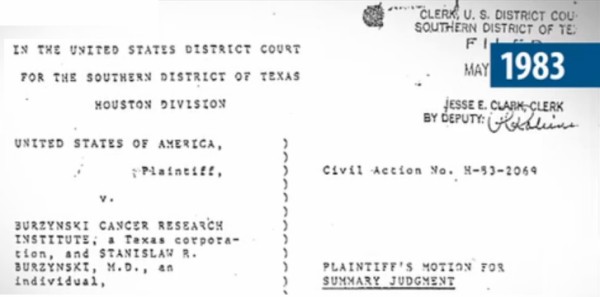
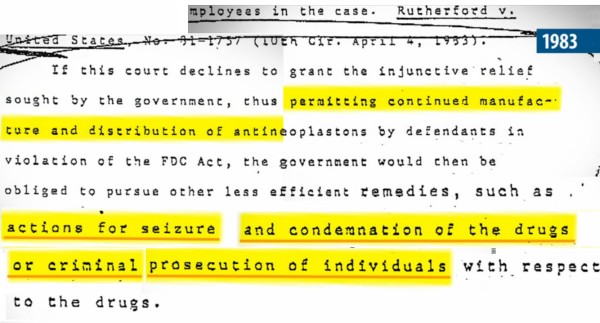
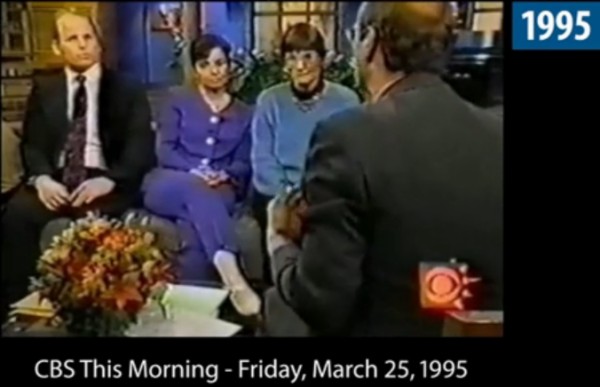
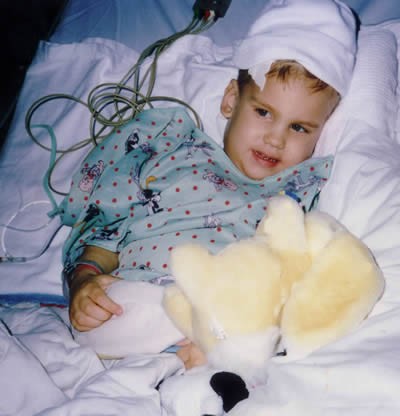
Dustin Kennari, one
of the kids whose life would have been
endangered by the loss of Burzynski's medication
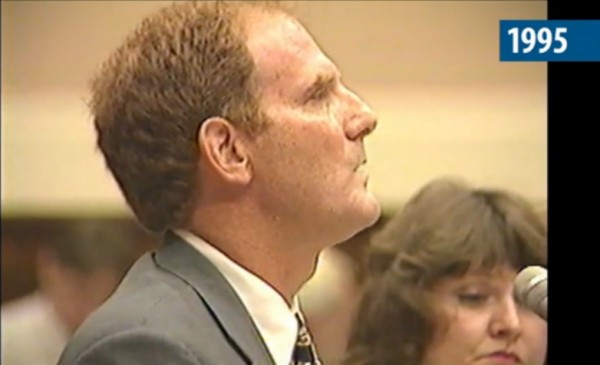
This is Burzynski
attorney Richard Jaffe and Mary Michaels.
Mrs. Michaels was
the mother whose testimony flustered
the State of Texas prosecutor so badly he said,
"Oh,
never mind. No more questions."
These parents had
every right to be upset at the
nasty games being played at their children's expense.
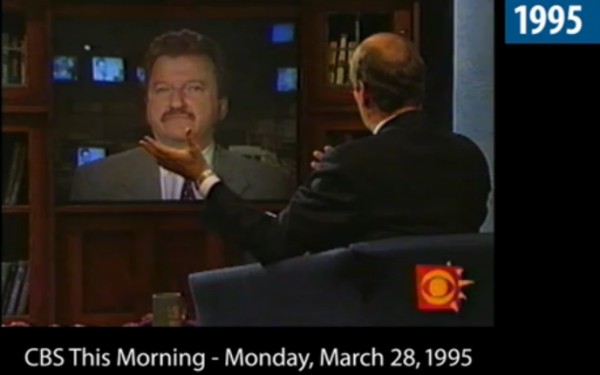
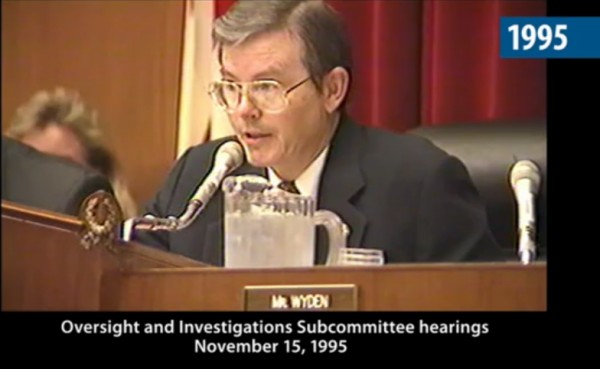
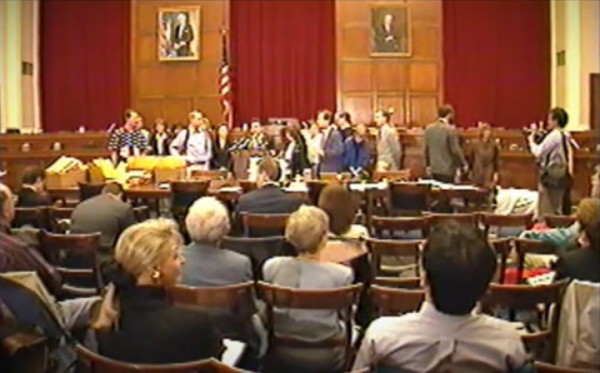
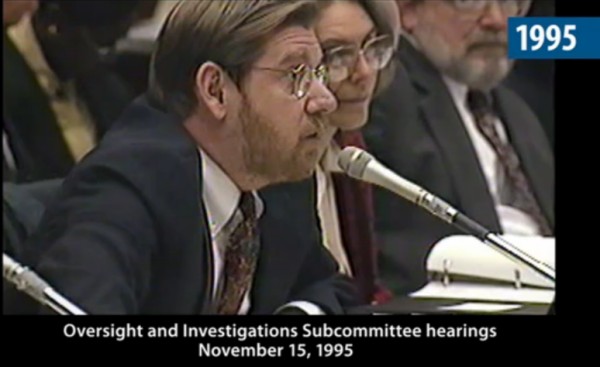
Dr. David Kessler:
Mr. Chairman, how do you know that there were
no findings of fault that were
returned from that grand jury?
Hon. Joe
Barton: There have been no indictments returned.
Dr. David Kessler: Mr. Chairman, I’ll ask council to comment, but I don’t
think those are the same—as a matter of law those are
the same things.
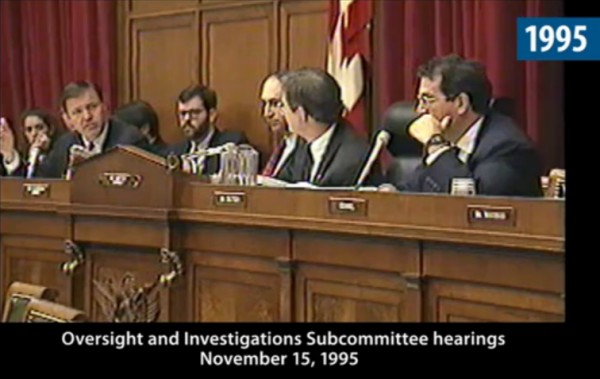
I am
just trying to understand the exchange between the witness
and the Chairman.
What
I understood the Chairman to say is that there have been
FOUR GRAND JURIES CONVENED?
Hon. Joe
Barton: At least four.
|
| |
|
1996 - The Second Congressional Subcommittee Hearing with
Joe Barton
Dustin Kennari
Barely a week
after Barton's hearings concluded, on November 20th, 1995,
Dr. Stanislaw Burzynski was indicted. Burzynski was charged
with 75 counts of violating federal law and fraud. The
charges were engaging in interstate commerce as well as
insurance and mail fraud.
Specifically, Dr. Burzynski was charged with 40 counts of
distributing a non-FDA approved drug in interstate commerce,
34 counts of mail fraud, and one count of contempt of court
for violating the order against interstate delivery of
Antineoplastons.
If convicted, Burzynski would face a maximum of 290 years in
a federal prison, and $18.5 million dollars in fines.
ABC anchor:
On February
9th, 1996, Houston federal court judge Sim Lake ruled
Dr. Burzynski’s treatments have been quote “illegal
under Texas and Federal Law since 1984” and he
ordered them stopped on all but a handful of patients.
Then he put
a stay on his own order, a temporary stay of execution.
On February 9,
1996, US District Court Judge Sim Lake ruled that Dr.
Burzynski cannot treat patients outside of clinical trials.
In other words, he issued a death sentence for hundreds of
Dr. Burzynski's patients.
Now the adult
patients as well as the parents of the cancer-stricken
children were terrified. Judge Lake had come within
inches of forbidding what they considered to be their
life-saving treatment. They were really upset. So they
went to Joe Barton and asked him to intervene again.
Second
Congressional Hearing, Joe Barton
Dr.
Burzynski has benefited in his legal battles from the
inevitable slowness of legal proceedings and from having
supporters in Congress, like Representative Joe L.
Barton, Republican of Texas.
Mr. Barton
held three hearings in the last year on whether the
F.D.A. had abused its power, where Dr. Burzynski's
patients provided a poignant note by testifying that the
agency wanted to deprive them of a lifesaving drug.
Source:
New York Times, 1996
.............
NARRATOR:
In 1996, not
only did scores of Dr. Burzynski’s patients return to
Washington DC to protest his indictment, but many of
them testified again before another Congressional
Hearing headed by Congressman Joe Barton.
............
After Burzynski
was indicted, Joe Barton conducted a second Congressional
hearing in 1996.
This set the
scene for the incredibly dramatic, tear-filled testimony of
Mariann Kunnari, the mother of Dustin Kunnari, a 4 year old
cancer-stricken patient of Dr. Burzynski.
ARCHIVAL
FOOTAGE: Congressional Subcommittee Hearing 2/29/96:
Hon. Joe
Barton: Our first witness is Mariann Kunnari, is
that correct?
Mariann Kunnari:
Yes, that’s correct.
Hon. Joe Barton: From Aurora, Minnesota.
Mariann
Kunnari (with son Dustin at her side):
This is
Dustin Kunnari and he is on Dr. Burzynski’s antineoplaston
treatment. And this is my husband, Jack Kunnari. Now, in
February of 1994 our lives were drastically changed. My son
Dustin was only two and a half years old at the time—he has
diagnosed with a brain tumor the size of a golf ball.
The surgeon
removed 75% of his tumor, and the remaining 25% was
diagnosed from a biopsy as a malignant, very aggressive
medulloblastoma brain tumor—one of the most deadly forms of
brain cancer.
The doctors
told us Dustin had only a few months to live. The first
treatment offered us was radiation. But the radiation
doctor told us that at his young age, Dustin would become a
vegetable, and it would only extend his life for maybe a few
months.
The next
doctor wanted us to enroll Dustin into an experimental
chemotherapy, which was highly toxic. The side effects would
include hearing loss, kidney and liver damage, bladder,
stunted growth and a possible leukemia.
One question
I’d like to ask is: would you do that to your child?
We weighed the harm these experimental drugs would cause
against the fact that they would not cure Dustin, and
decided not to subject him to these drastic measures.
But our
oncologists told us that their opinion took precedence over
us as parents. This put added stress to the already
stressful situation we were in.
In April of
1994, we visited Dr. Stanislaw Burzynski in Houston. Dr.
Burzynski made us no promises, but said, that he “often had
good results with brain tumors, at worst it would not hurt
Dustin” and it offered the best hope in a longer quality of
life.
An MRI six
weeks after we started Dr. Burzynski’s treatment revealed no
tumor. We were very overjoyed.
Dustin continued Antineoplaston therapy, and one year later
a tumor one-inch by one-inch in size was found on the MRI,
that would be in April of 1995.
Dr. Burzynski
immediately raised Dustin’s dose of Antineoplastons. There
were still no harsh side-effects at all. The next MRI in
September of 1995 revealed that the tumor had almost
disappeared again.
To this day, it has not reappeared. If
you look at Dustin right now, he’s a happy, healthy
four-year-old, who has out-lived his prognosis. There is not
a traditional treatment that would have kept him alive, with
such good quality of life.
FDA Commissioner David Kessler loves to grab headlines as a
man who loves children so much he wants to protect them from
the ravishes of smoking.
If Dr. Kessler loves children so much, why have he and his
agency been trying so hard to cut off my son’s last hope for
life? Without this treatment, my son will die.
................
NARRATOR
(with photos of Dustin Kunnari):
This is a photo of Dustin Kunnari at four years old in
1996. This is photo of Dustin Kunnari at 18 years old in
2009.
Dustin's
brain cancer never returned.
|
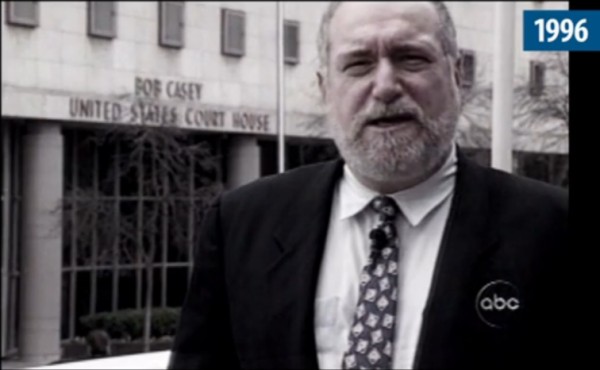
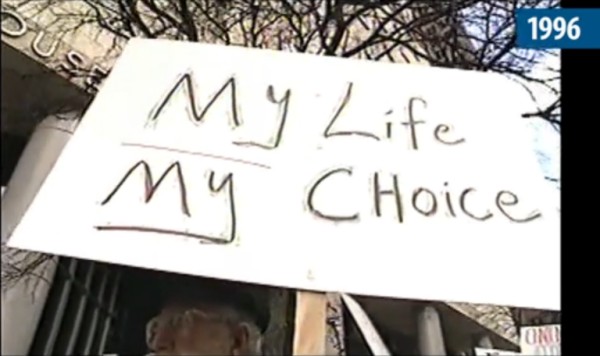
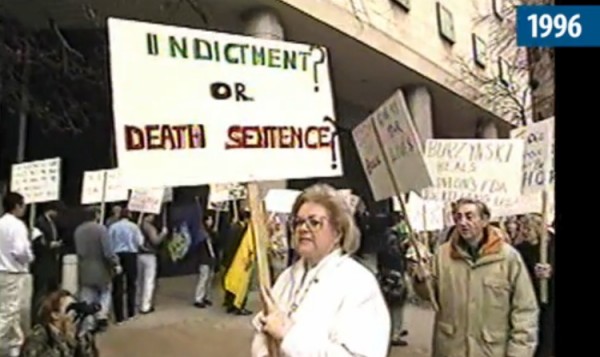
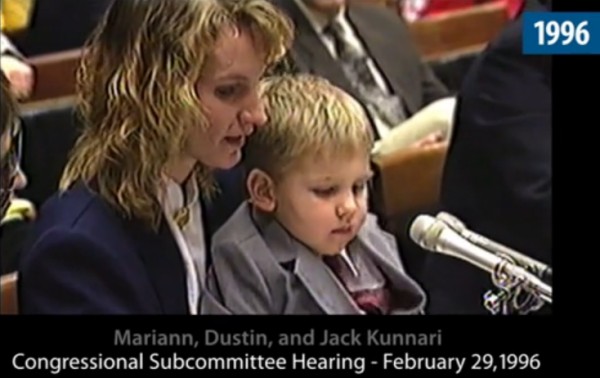
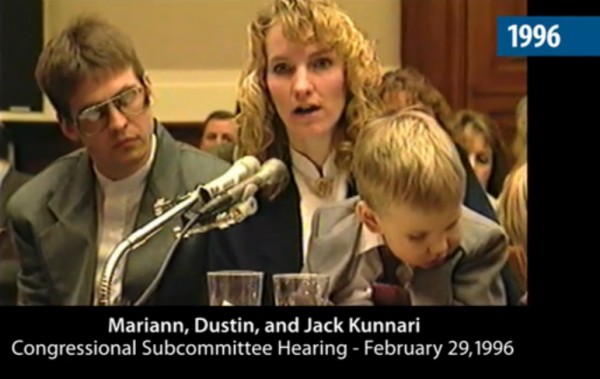
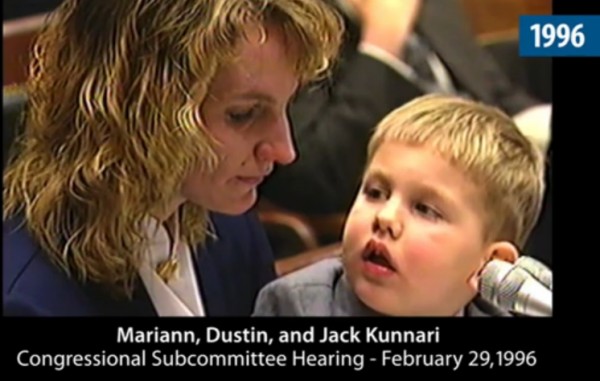
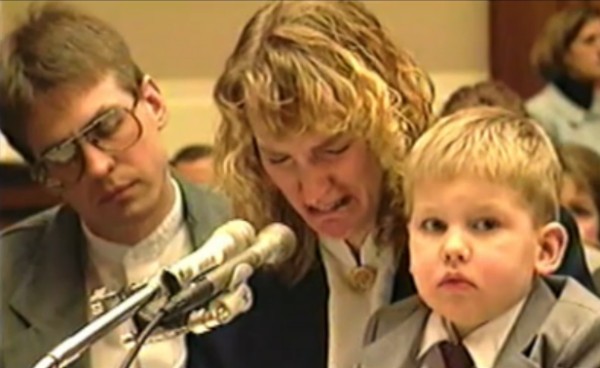
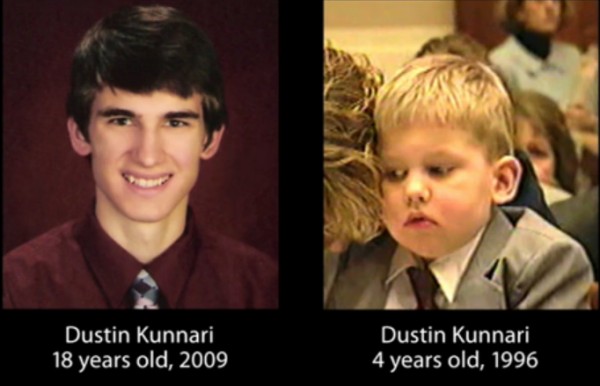 |
| |
|
The
1996 Grand Jury Trial -
Round One and Two
|
There was an
ironic twist to Burzynski's indictment. As
part of Burzynski's bond agreement, federal judge Sim Lake
ordered Burzynski and the FDA to agree on protocols for
Phase II trials of antineoplastons — trials to measure the
drug's efficacy.
So while the FDA, via a federal
prosecutor, was trying to imprison Burzynski, it was also
ordered to monitor his clinical
trials. The coming prosecution
would mark the first time the FDA had tried to jail a
scientist for using a drug on which he is concurretnly
conducting FDA-authorized clinical trials.
Dr. STANISLAW
BURZYNSKI - on camera interview:
In 1996,
because of pressure from the politicians and American
opinion, the FDA agreed to accept all of the patients
for whom we had at the time into a program of Phase II
clinical trials. Basically we filed and received
permission from the FDA to proceed with 72 different
Phase II clinical trials which covered practically any
type of cancer.
This was
such tremendous work, that basically it was necessary
for me to work almost around-the-clock, with six
secretaries who were typing different protocols, and
later I learned that the FDA had to create a special
task force to review these protocols.
We have soft
tissue sarcoma, there is a special protocol for that.
You have breast cancer—a special protocol. For lung
cancer, a few different protocols. For brain tumors,
about over twenty different protocols for different
types of brain tumors.
NARRATOR:
So, just a
year before his trial facing life in prison, the Food
and Drug Administration had finally authorized the very
thing that Dr. Burzynski and his patients had ever
wanted.
Even still,
the FDA would not back down in making sure Burzynski’s
criminal trial moved forward.
................
As the trial got
underway in December 1996, the absurdities were never more
apparent.
Why would the
FDA try to jail a scientist for using a drug on which his
conducting FDA-authorized trials? How much sense
does that make?
Who on earth
would prosecute someone for using a drug that they
themselves concede has been saving lives?
What is the
purpose of hiding the fact that Burzynski's treatment saves
lives from the jury?
Perhaps never in
the history of law has anyone uttered a weirder statement
than Asst. U.S. Attorney Mike Clark.
Clark, terrified
the jury might find out that Burzynski was actually
successfully curing cancer, warned the judge against the
sinister "thinly veiled effort to expose the jury to the
specter of Dr. Burzynski in his act of saving lives."
Talk about a
Kangaroo Court. And this on the Federal level?
The trial began
in January 1997 and lasted two months. The jury was
supposed to decide whether Burzynski is a fraud or a medical
pioneer.
The question one
might raise is how are they supposed to determine he is a
medical pioneer if the judge rules they can't hear testimony
as to the power of Burzynski's treatment?
Now one begins
to understand why the prosecutor was leery of exposing the
jury to Burzynski's legion of supporters... there was no way
he could win the case.
Back in the
Fifties, the FDA had managed to shut down Harry Hoxsey, an
alternative cancer healer, because he had clinics in several
states... and therefore had to transport his anti-cancer
drug out of Texas to the other clinics.
Here in 1997,
the FDA was trying to use this same trick again. There
was only one problem - Burzynski was by nature a careful
man. As far back as 1977, Burzynski was well aware
that he was not allowed to send antineoplastons across state
lines.
But patients
could come to his clinic from another state and take
antineoplastons back home with them. This was legal and the
FDA was well aware of it.
But the FDA had
become so desperate after 3 previous grand juries failed to
bring an indictment, this time they managed to convince a
grand jury that a new interpretation did constitute
interstate commerce.
Furthermore the
FDA stacked the deck. For example, during the trial,
patients were not allowed to testify about how well the
antineoplaston treatment worked or how safe it was.
In addition,
Oncologist Robert Burdick, MD of Seattle, Washington, had
reviewed Burzynski's patients and vouched for his treatment.
Burdick sent a remarkable
letter
to Federal Judge Sim Lake in support of
Burzynski. The letter explained how Burzynski had
achieved impressive cure rates, but it was all for naught. Judge Lake disregarded it, ruling
the report irrelevant.
Despite the government's efforts to suppress
evidence favorable to Burzynski, the best they could do was
get a tie. The Jurors were hopelessly deadlocked 6 to 6.
On March 3,
1997, Judge Sim Lake declared a mistrial.
Even that didn't stop the government. The FDA refused
to back down. Try, try again... literally.
NARRATOR:
The FDA took
Dr. Burzynski to trial again.
They had
even less luck the second time. The FDA’s facade
in trying to convince the world that Burzynski was a
criminal was completely unraveling.
In an interesting twist, some of the jurors who voted
not guilty in the first case decided to take time off
from work to join the patients’ protest in front of the
court house during the second case.
After
apparently accepting the absurdity of their case, right
before the second trial began on May 19th the FDA
suddenly dropped 40 of the 41 remaining charges.
They went
forward on the last count.
[SOURCE: NY
Times 5/18/97] [SOURCE: Court Document showing Dismissal]
.........
A second federal
trial got underway May 19, 1997 to try Dr. Burzynski on the
contempt of court charge for violating the order against
interstate delivery of Antineoplastons.
This was the government's last chance. The federal
government claimed Dr. Burzynski violated the previous court
order because he continued to treat patients who lived out
of state, knowing they might ship the drug across state
lines.
The defense, however, argued that Dr. Burzynski
treated patients who lived outside Texas, but that he didn't
ship the drug to other states.
The absurdity of
this allegation was that the FDA had given Burzynski
permission to send antineoplastons out of state as part of
the clinical trials. How could the government possibly
win on this issue?
A federal jury
acquitted Dr. Burzynski on May 27, 1997.
To this date,
Dr. Burzynski has never lost a trial.
|
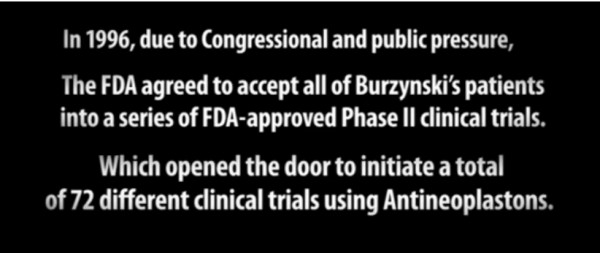
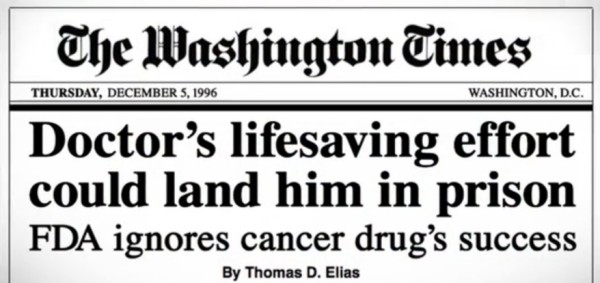
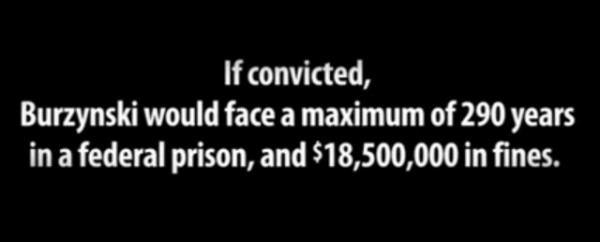
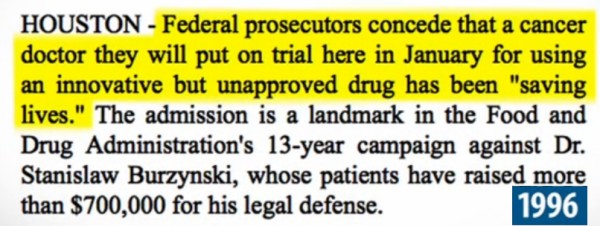
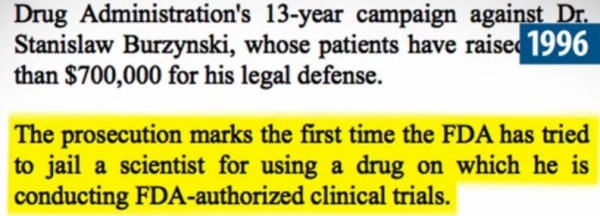
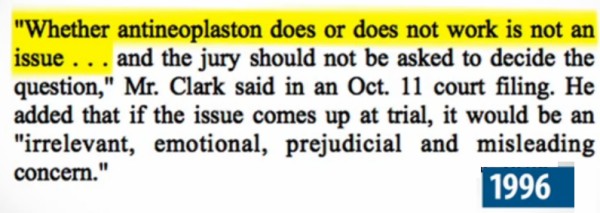


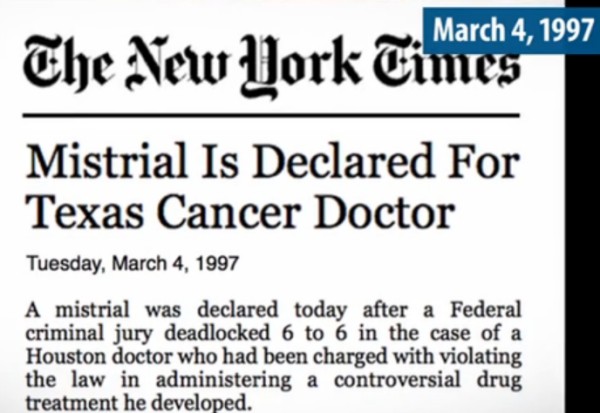
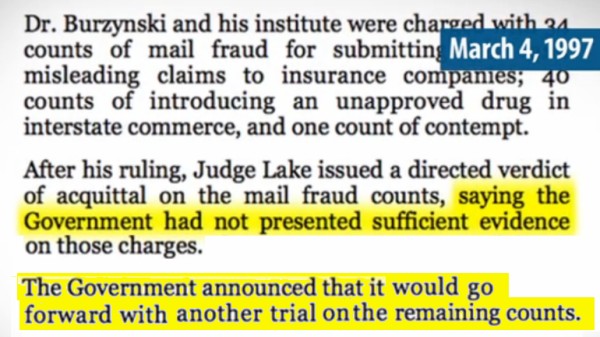
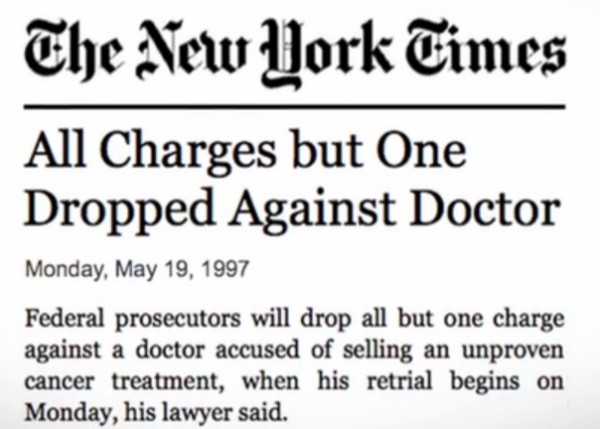 |
Dr. STANISLAW
BURZYNSKI - on camera interview:
There were
many patients who would have liked to testify on our
behalf and convince the jury and the judge that without
the treatment they would die.
But Judge
Lake did not admit any statements which could show that
the treatment is effective. Nor did the judge
allow the jury to visit our facility where we produce
the medicine; they were trying to keep it away from the
jury.
If this
information would have been presented to the jurors,
then this trial would have been finished very quickly.
[SOURCE:
Washington Times 12/5/96]
And that’s
what the jurors told us because after the trial we
talked to the jurors, and they were shocked that such
information about the treatment which was saving the
lives of patients was not presented to them.
And I was
sick listening to the lies of prosecutors from the U.S.
Attorneys. It was not necessary for them to do it, they
could tell the truth, they represented the biggest
power, but they still were doing this all the time.
So they were
trying to do it in a sneaky way, and that’s what is
horrible, that’s what should be exposed because I think
the United States deserves better.
|
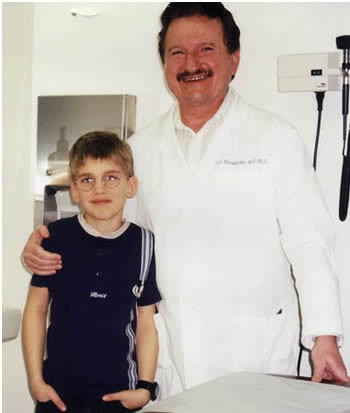 |
|
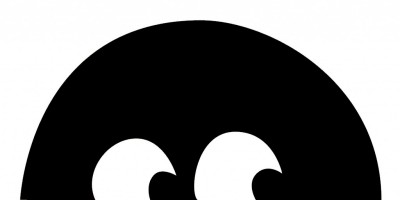 |
CONSPIRACY
|
|
The
60 Million Dollar Man
After the smoke
cleared and all the lawyer's fees were added up, a very
remarkable statistic emerged.
The government spent $60 million dollars trying to put Burzynski in
jail...
$60,000,000 for just this one Federal
trial.
The cost for all
the trials put together is somewhere in excess of
$200,000,000. Burzynski's legal fees are equally
staggering.
And what about
those 11 copycat patents?
As they say,
"Imitation is the highest form of flattery".
|
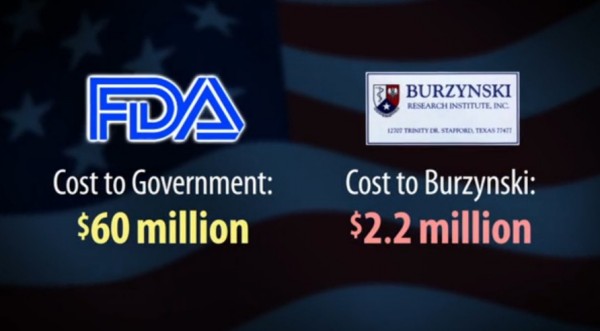 |
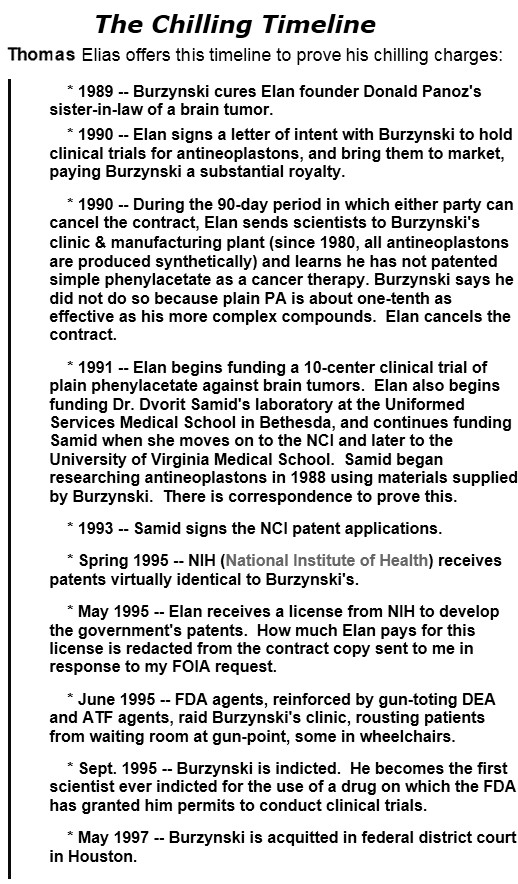
Source of Timeline Picture
|
Why??
Gavin Phillips:
So the
FDA wasted many millions of taxpayer dollars trying to convict you
on false charges of transporting Antineoplastons across State lines.
What was the motivation for this vendetta?
Stanislaw Burzynski: Well,
it’s hard to tell, because why they did it was never properly
investigated. But we have some leads.
For instance, on one
side you have a large pharmaceutical company, which was very
interested in getting hold of our patents; this is Elan
Pharmaceutical. It happened that I treated successfully a close
relative to the CEO of Elan.
Elan became very
interested in what we have. They came close to signing a final
license agreement. But after they learned what we have, they decided
to withdraw and then suddenly the FDA and NCI gave their full
support to Elan, to do clinical trials with one of the ingredients
of Antineoplastons, phenylacetate.
This was a large pharmaceutical company that was trying to
appropriate my invention. On the other hand, within the FDA and NCI
you have had people who were working closely with this company. For
instance Mary Pendergast, who was responsible for the legal action
against us, became Vice President of Elan.
Also Doctor Michael
Friedman, who was initially in charge of NCI cancer research, and
who knew that our treatment works, later became commissioner of FDA
and he did whatever he could to put us out of business. Not only
that, but to simply destroy me.
On the other hand, suddenly the government decided to file for the
patents, which claimed the same thing that our patents did. Never in
the history of the United States do you have the issuance of two
patents for the same invention. It was really a breach of patent
procedure. The patent office allowed them to patent something I
invented, and which I patented. And dishonest scientist Dr. Dvorit
Samid, who initially worked for us, was receiving funds from us and
finally went for the higher bidder (Elan).
So you have a lot of leads, which indicate that there was something
between the government, dishonest scientists like Dvorit Samid and
the large pharmaceutical company, Elan.
It was in their best
interests for them to get rid of me, destroy me, so they could
appropriate my discoveries and benefit from that.
Source:
Gavin
Phillips Interview
|
|
|
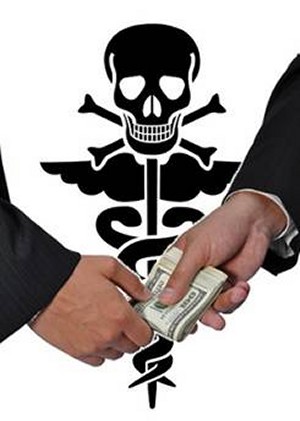 |
PROFIT
OVER PEOPLE
"It's time you learned the facts of life.
You
see, there are really only two kinds of people
in the world, the eaters and the eaten. You just
have to make up your mind which group you're
going to be in.
When you have the power,
you don't have to tell the truth.
That's a rule
that's been working in this world for
generations. And there are a great many
people who don't tell the truth when they are in
power in administrative positions."
Dr. Dean
Burk, the NCI biochemist who never wavered in his
support of Laetrile.
|
|
Rick Archer's Note: The unquestioned star
of the Burzynski documentary has to be Dr. Li-Chuan Chen.
It took a lot of guts for him to go on camera and vividly
explain the corrupt behind-the-scenes practices at the
National Cancer Institute.
I got goosebumps
watching Dr. Chen come forward and document with his own
eyes that people were deliberately trying to steal
Burzynski's work behind his back with copycat patents.
In addition, Dr.
Chen backed up Burzynski's claim that people
at the National Cancer Institute deliberately sabotaged
tests that were meant to investigate Burzynski's work. He
knew this because he saw it happen. Chen's exact
words:
"...when the
NCI or its assigned entity conducted trials on
alternative cancer therapies, they always altered the
Protocol and let it fail in order to discredit the
therapy."
Dr. Chen went on
to say,
"Scientists
never look at it carefully, because Papa is telling you
something and you don't question him."
It was never
spelled out in black and white, but I got the impression that the nine
cancer patients who participated in the sabotaged trial all died thanks to the altered protocols. Burzynski
has commented on this himself:
SB: "Because,
obviously, they [NCI] knew what they were doing, and they knew
that these patients have really no chance to respond to
any treatment.
They are going to die, okay? And
that’s what happened.
After we
realized what they do, we decided to force them to stop
clinical trials. And since then, obviously, National
Cancer Institute hates us, okay? They do whatever they
can to not cooperate with us anymore.
Correct me if I
am wrong, but it seems Burzynski is
saying those sick patients were deliberately sacrificed so
the NCI could rig the clinical test and tell the world Burzynski's treatment didn't work.
Profits over
people...let them die so we can discredit this guy.
Now the movie Coma doesn't seem quite so 'fictional' any
more. Those cancer patients were not 'lab rats'; they were
human beings. When doctors start sacrificing patients'
lives just to rig an academic point, something is deeply
wrong here.
The
Final Word
Burzynski's
Documentary had
a morbidly fascinating ending.
If one is to
believe Dr. Chen, the U.S. Patent Office was in on the fix.
Dr. Chen was forthright in asserting the
government deliberately filed copycat patents on Burzynski’s
antineoplastons compounds.
This office issued 11 copycat patents on medical therapies
that Burzynski had already patented himself.
These
patents were issued to Dvorit Samid, Burzynski's former lab
assistant who had nothing to do with their original
discovery.
Question:
Why would the U.S. Patent Office assign fraudulent patents
to some of the most powerful institutions in American
government?
Possible
Answer: Because
Burzynski already held the original patent. All
Burzynski would need now would be to plow his way through the
excruciatingly expensive Phase III "efficacy" trials.
If Dr.
Burzynski's antineoplastons are
approved, it would mark the first
time in history that a single scientist, not a pharmaceutical
company, would hold the exclusive
patent and distribution rights on an
industry-shifting medical breakthrough.
When that
happens,
the game is
over. Checkmate to Burzynski, Nobel Prize for Medicine
certain to follow.
Note that all of
this NCI patent chicanery was taking place while these same
government agencies were spending $60 million dollars of
taxpayer money trying to put Dr. Burzynski in jail.
Now ask yourself
this: Why would anyone spend $60 million dollars trying to
put Burzynski in jail?
If this man
really is a quack doctor with an ineffective treatment, then
he is a nobody. Word of mouth drives his business.
If no one survives for long, then his business dries up automatically.
Did they spend
$60 million to protect the patients?
Hell, no. Even if every single one of Burzynski's patients
were doomed (which they aren't), everyone agrees Burzynski's treatment is a
dramatic
improvement over chemo because it doesn't hurt anybody.
So that can't be the answer either.
The most obvious
conclusion is that if Burzynski was in jail,
he could not fight the criminal theft of his discovery.
People ask me,
"Rick, does Burzynski's treatment work?"
And I am going
to say this again, "Why would anyone spend 14 years and $60
million dollars trying to put Burzynski in jail?"
There is your
answer right there. If Burzynski did not represent the
greatest possible threat to the entrenched interests, then
they would not go to these extremes.
According to Dr. Chen, the absurd $60 million dollar,
14-year spectacle of one useless trial after another was nothing more than a smoke and mirrors attempt to
muscle the doctor out of the picture so the NCI could steal
his treatment.
"Under the capitalist sun, there is nothing
sacred.
Money talks."
Do these people have
no shame? Were they born without a conscience? I
cannot begin to understand how they turn a blind eye to the
suffering of the people crying for a cure to cancer.
I have spent the
past three Chapters attempting to illustrate that the United
States cancer
treatment and pharmaceutical drug industries are rife with
corruption and conspiracy.
The situation is so bad it seems like
the industry itself has cancer.
I rest my case.
Rick Archer
August 2013
|

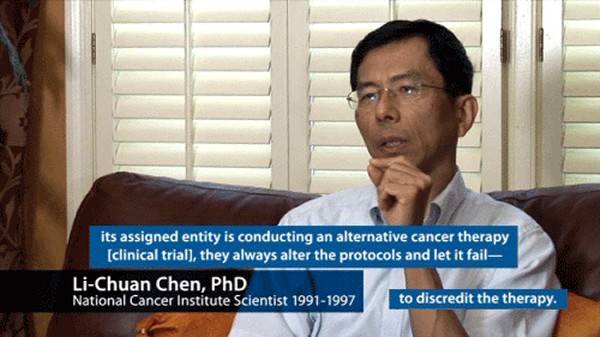
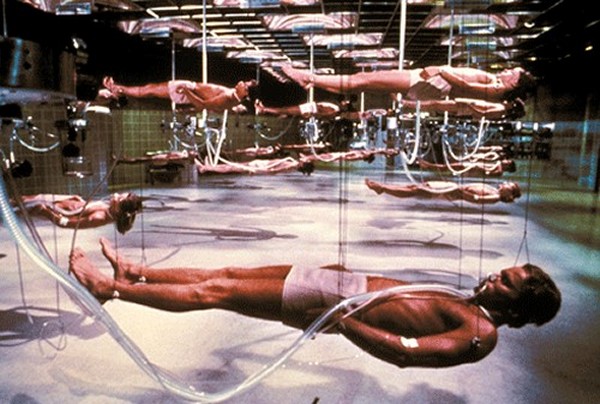


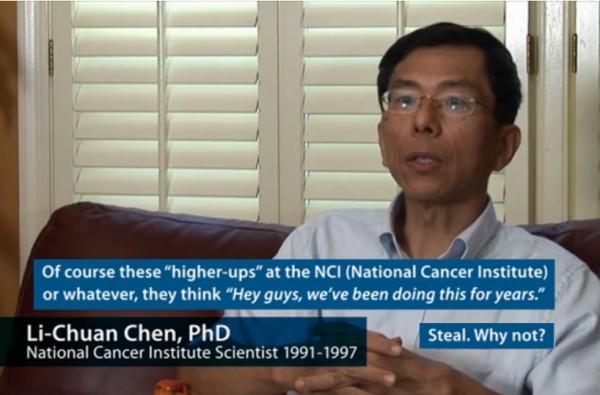
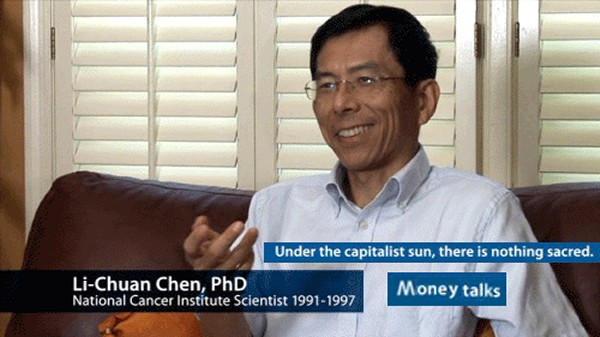 |
Chapter Four:
Royal Rife
Rick
Archer's Note: Of all the chapters I wrote for the
Cancer Diaries, the story of Royal Rife was by far the most
disturbing. There seems to be ample circumstantial
evidence that the work of a medical genius was deliberately
sabotaged.
For questions
and comments:
dance@ssqq.com
I will honor any request to keep your comments private.
By the way, if you wish to know more
about who I am:
Rick
Archer
|
|